Great Northern War
Great Northern War

Battles and Sieges of the Great Northern War (1700-1721)
Phase 1: Swedish dominance (1700-1709)
Danish theatre of war (1700)
Humlebæk - Tönning I
Livonian/Estonian theatre of war (1700-1708)
Riga I - Jungfernhof - Varja - Pühhajoggi - Narva - Petschora - Düna - Rauge - Erastfer - Hummelshof - Embach - Tartu - Narva II - Wesenberg I - Wesenberg II
Ingermanland / Finnish theatre of war (from 1701)
Arkhangelsk - Lake Ladoga - Gothenburg - Nyenschanz - Neva - Systerbäck - Petersburg - Vyborg I - Porvoo - Neva II - Koporje II - Kolkanpää
Lithuanian-Belarusian theatre of war (1702-1706)
Vilnius - Saladen - Jakobstadt - Gemauerthof - Mitau - Grodno I - Olkieniki - Nyazvish - Klezk - Lyakhavichy
Polish theatre of war (1702-1706)
Klissow - Pułtusk - Thorn - Lviv - Warsaw - Poznan - Punitz - Tillendorf - Rakowitz - Praga - Fraustadt - Kalisch
Russian theatre of war (1708-1709)
Grodno II - Golovchin - Molyatichi - Rajovka - Lesnaya - Desna - Baturyn - Koniecpol - Weprik - Opishnya - Krasnokutsk - Sokolki - Poltava I - Poltava II
Phase 2: Sweden on the defensive (1710-1721)
Baltic and Finnish theatre of war (until 1714)
Riga II - Vyborg II - Pernau - Kexholm - Reval - Hogland - Pälkäne - Storkyro - Nyslott - Hanko
Swedish/Norwegian theatre of war (1710-1721)
Helsingborg - Køge Bay - Gulf of Bothnia - Frederikshald I - Dynekilen Fjord - Gothenburg I - Strömstad - Trondheim - Frederikshald II - Marstrand - Ösel - Gothenburg II - Södra Stäket - Grönham - Sundsvall
North German theatre of war (1711-1716)
Elbing - Wismar I - Lübow - Stralsund I - Greifswalder Bodden I - Stade - Rügen - Gadebusch - Altona - Toenning II - Szczecin - Fehmarn - Wismar II - Stralsund II - Jasmund - Peenemünde - Greifswalder Bodden II - Stresow
Treaties during the Great Northern War (1699-1721).
Alliance treaties
Preobrazhenskoye (1699) - Dresden (1699) - Narva (1704) - Dresden (1709) - Thorn (1709) - Copenhagen (1709) - Hanover (1710) - Lutsk (1711) - Adrianople (1713) - Schwedt (1713) - Stettin (1715) - Berlin (1715) - Greifswald (1715)
Peace treaties
Traventhal (1700) - Warsaw (1705) - Altranstädt (1706) - Pruth (1711) - Frederiksborg (1720) - Stockholm (1719) - Stockholm (1720) - Nystad (1721) - Stockholm (1729)
Capitulations
Estonia and Livonia (1710)
The Great Northern War was a war fought in Northern, Central and Eastern Europe between 1700 and 1721 for supremacy in the Baltic region.
In March 1700, a tripartite alliance consisting of the Russian Tsarist Empire and the two personal unions Saxe-Poland and Denmark-Norway attacked the Swedish Empire, which was ruled by the eighteen-year-old King Charles XII. Despite the unfavourable starting position, the Swedish king initially remained victorious and managed to get Denmark-Norway (1700) and Saxe-Poland (1706) to withdraw from the war. When he set out to defeat Russia in a final campaign from 1708, the Swedes suffered a devastating defeat at the Battle of Poltava in July 1709, which marked the turn of the war.
Encouraged by this defeat of their former enemy, Denmark and Saxony re-entered the war against Sweden. From then until the end of the war, the Allies kept the initiative and pushed the Swedes on the defensive. Only after the Swedish king, who was regarded as intransigent and obsessed with war, fell during a siege outside Frederikshald in Norway in the autumn of 1718 could the war, which had become hopeless for his country, be ended. The terms of the peace treaties of Stockholm, Frederiksborg and Nystad meant the end of Sweden as a major European power and the simultaneous rise of the Russian Empire founded by Peter I in 1721.
Previous story
Swedish rise to great power

Since the 16th century, the struggle for a Dominium maris Baltici, i.e. the rule spanning the Baltic Sea as the driving force of historical development, gave north-eastern Europe its character. It began as early as the Middle Ages. It was primarily based on the striving to exploit the natural riches of the coastal countries.
The striving for the Dominium maris Baltici, i.e. dominion over the Baltic Sea region, was the trigger for many warlike conflicts between the Baltic Sea countries even before the Great Northern War (cf. Nordic Wars). The causes of the Great Northern War were manifold. In numerous wars against the kingdoms of Denmark (seven wars) and Poland-Lithuania (five wars) as well as the Russian Tsarist Empire (four wars) and a war against Brandenburg-Prussia, Sweden, which was mostly victorious, was able to gain supremacy in the Baltic Sea region by 1660 and defend it from then on.
As the guarantor of the Peace of Westphalia, Sweden had officially become a major European power in 1648, having already taken away the Tsarist Empire's access to the Baltic Sea in the Peace of Stolbowo in 1617. However, Sweden's newly won European great power position in the Thirty Years' War stood on a weak foundation. The Swedish heartland (essentially present-day Sweden and Finland) had a comparatively small population of barely two million inhabitants and thus only about one tenth to one fifth of the inhabitants of the other Baltic states (the Holy Roman Empire, Poland-Lithuania or Russia). The economic base of the Swedish heartland was narrow. Sweden's position of great power was decisively based on the extraordinary power of its army. To finance it, Sweden was crucially dependent on sources of revenue such as the port duties of large Baltic ports like Riga (the largest city in the Swedish Baltic Sea Empire), Wismar or Stettin (in Swedish Pomerania) as well as river duties on the Elbe and Weser.
In 1655, the Second Northern War began, which ended with the Peace of Oliva in 1660. In this war, Charles X Gustav forced the Polish King John II. Casimir, who was a great-grandson of King Gustav I of Sweden and the last living Wasa, to renounce the Swedish royal throne and Denmark to unrestricted rule over the Sound. As in the Thirty Years' War, Sweden was supported by France in foreign policy and subsidy payments in the following years and was thus able to preserve its possessions.
The post-war state had to be feared by Sweden in particular, because the tendencies to revise of the neighbours Denmark, Brandenburg, Poland and Russia, who were affected by Sweden's expansion, had already hardly remained hidden during the peace negotiations. The legacy of the warlike era of great power rise for the peaceful period of great power securing after 1660 remained difficult: for these foreign policy securing tasks, i.e. for the maintenance of a large military potential at home, Sweden was still very unfavourable in its structural conditions. After the defeat at the hands of Brandenburg-Prussia at Fehrbellin in 1675, Sweden's precarious situation became obvious to foreign countries as well. For this reason, King Charles XI convened the Diet in 1680. With the help of the peasants, the burghers, the officers and the lower nobility, the repossession of the former crown lands from the nobility was pushed through, the Imperial Council was demoted to an advisory Royal Council, and legislation and foreign policy, which until then had rested with the Imperial Diet, were taken over by the King. The king became the absolutist autocrat. After the political reforms, Charles XI carried out an extensive and overdue reorganisation of the military. In 1697, Charles XI left his son and successor Charles XII a reformed absolutist great power state and a reorganised and effective army.
Formation of a Triple Alliance
It was part of Swedish diplomacy to control Denmark and Poland through contractual reassurances with Russia in such a way that an encirclement could be avoided. Subsequently, Bengt Oxenstierna's diplomacy could no longer avert the danger of encirclement.
At the end of the 17th century, the following lines of conflict were emerging in north-eastern Europe: Denmark had relegated from its position as the dominant state in Scandinavia to a middle power with limited influence and saw its control over the remaining Baltic Sea accesses endangered. Although customs duties from foreign ships were the kingdom's most important source of revenue, the threat of outside interference was ever present. One point of contention between Denmark and Sweden was the question of Gottorf's shares in the duchies of Holstein and especially Schleswig. In 1544, the duchies were divided into royal, Gottorf and jointly governed shares. Holstein remained an imperial fiefdom and Schleswig a Danish fiefdom. After the Peace of Roskilde in 1658, the shares of the Gottorfs in the Duchy of Schleswig, who were allied with the Swedes, were released from Danish feudal sovereignty. Danish foreign policy, which saw itself threatened from two sides by the Gottorfer's alliance with the Swedes, attempted to re-appropriate the lost territories. The independence of the partial duchy of Schleswig-Holstein-Gottorf was only guaranteed by the Swedish government, which assumed that with the allied territory it had a strategic base for troop deployments and attacks on the Danish mainland in the event of a war against Denmark. Another point of contention between Denmark and Sweden were the provinces of Skåne, Blekinge and Halland, which had historically been core countries of the Danish state but had belonged to Sweden since the Peace of Roskilde in 1658. In these newly won provinces, Sweden rigorously suppressed all pro-Danish aspirations. The dispute over the state affiliation of Schonen had already led to Denmark's ultimately unsuccessful entry into the Nordic War of 1674 to 1679 in 1675.
In Russia, Tsar Peter I (1672-1725) pursued an opening of his country towards Western Europe. In his view, a prerequisite for this was free access to the world's oceans. Sweden controlled the Baltic Sea and the mouths of the Neva and Narva rivers. The Black Sea, as an inland sea, offered only limited access to the world's oceans, as the Ottoman Turks controlled its outlet at the Bosporus. Only through the Arctic Sea port of Arkhangelsk could Russia engage in maritime trade with the rest of Europe. Although Russia had mineral resources, furs and raw materials, it could not trade profitably with the West without a suitable sea route.
Elector Friedrich August I of Saxony (1670-1733) had been elected King of Poland (and thus also ruler of Lithuania, see Saxe-Poland) in 1697 as August II. Since the nobility had a great influence on decisions in the Polish-Lithuanian dominion, August II strove to gain recognition, shift the balance of power in his favour and transform the kingship into a hereditary monarchy. In this he was advised by Johann Reinhold von Patkul (1660-1707), who had fled from Swedish Livonia. He believed that the reconquest of the once Polish Livonia would help August gain some prestige. The Livonian nobility would welcome this step and rise up against Swedish rule. Under King Charles XI of Sweden (1655-1697), the so-called reductions had occurred, by which part of the nobility's landholdings passed to the crown. This practice met with resistance from the affected German Baltic nobility, especially in Livonia, whose leaders then sought foreign help.

The young King Charles XII spent almost his entire life on the battlefield. As a little crown prince, he began intensive training at the age of four and received his own horse; at seven he took over his own regiment. On the day of the coronation in November 1697, it was not a pastor who put the crown on him, but he himself, drinking vast quantities of alcohol that day and enjoying himself in a strange way, competing with others to see who, for example, could cut the throat of a calf most elegantly.
Soon after the accession of the only 15-year-old Charles XII of Sweden (1682-1718) to the throne, the three potential enemies of Sweden began to form an alliance. Already in the first year of his reign, the young king had made his brother-in-law Frederick IV (1671-1702), the Duke of Schleswig-Holstein-Gottorf, commander-in-chief of all Swedish troops in Germany and instructed him to improve the national defence of the Gottorf part-duchy. These obvious military preparations provided the impetus for the first alliance negotiations between Saxe-Poland and Russia in June 1698. In August 1698, Tsar Peter I and King August II met in Rawa, where they made initial arrangements for a joint attack on Sweden. At Patkul's instigation, the formal alliance between Saxe-Poland and Russia finally came into being on 11 November Jul. / 21 November 1699greg. with the Treaty of Preobrazhenskoye. On 23 Novemberjul. / 3 Decembergreg. another alliance was concluded between Tsar Peter I and King Frederick IV of Denmark (1671-1730). Denmark had also been allied with Saxony in a defensive alliance since March 1698. However, neither treaty explicitly mentioned Sweden as a target of these agreements. They merely obliged the contracting parties to provide each other with assistance in the event of an attack or if the trade of one of the countries was affected by other states. Furthermore, Tsar Peter inserted clauses according to which he was only bound by the provisions of the treaties after a peace agreement between Russia and the Ottoman Empire (→ Russo-Turkish War (1686-1700)).

Development of the Swedish Empire in Early Modern Europe (1560-1815)
Defence against the Allied attack on Sweden (1700)
Saxon and Danish attacks
On 12 February 1700, General Jacob Heinrich von Flemming, at the head of some 14,000 Saxon soldiers, invaded Livonia to take the province and its capital Riga. Governor General of Livonia was Field Marshal Count Erik von Dahlberg, who was also Sweden's most famous fortress builder and put his capital in an excellent state of defence. Faced with Riga's strong walls, the Saxons first took neighbouring Dünamünde (13-15 March 1700), which August II immediately renamed Augustusburg. Afterwards, the Saxon troops set up a blockade in front of Riga, but without seriously attacking the fortress. After eight weeks, however, Dahlberg's Swedes took the initiative and defeated the Saxons in the battle at Jungfernhof (6 May 1700). The Saxon troops retreated behind the Düna and waited for reinforcements. When these arrived in June 1700 under Field Marshal General Adam Heinrich von Steinau, August II personally accompanied them. Steinau returned to the attack in July, defeated a Swedish detachment under General Otto Vellingk near Jungfernhof and began the siege of Riga proper. When the siege made little progress, it was decided on the Saxon side to secure larger parts of Livonia first. For this reason, Kokenhusen Castle was also besieged in the autumn and captured on 17 October 1700. Afterwards, the Saxons sought their winter quarters in Courland. The Swedish troops in Livonia were recruited mainly from Estonians, Latvians and Finns and were on their own for the time being. It was to their advantage, however, that the Livonian nobility did not rise up against Swedish rule. Instead, peasant revolts occurred in the course of the Saxon invasion, which made the nobles lean all the more heavily on the Swedish crown.
In the meantime, King Frederick IV of Denmark had also declared war on Sweden on 11 March 1700. A Danish corps of 14,000 men had already been assembled on the Trave under the command of Duke Ferdinand Wilhelm of Württemberg. These troops set out on 17 March 1700, occupied several places in Holstein-Gottorf, and on 22 April 1700 closed in on Tönning. During the siege of Tönning, the town was shelled from 26 April. Meanwhile, only two cavalry regiments, the naval regiment and two battalions of infantry remained on Zealand. The protection of the Danish heartlands against Sweden was assigned as the main task to the Danish fleet, which set sail with 29 ships of the line and 15 frigates in May. It was commanded by the young Ulrik Christian Gyldenløve and was ordered to keep watch over the Swedish fleet in Karlskrona; should the Swedes set course for Danish territory, the order was to attack them immediately. In May 1700, meanwhile, a Swedish army was gathering from the regiments in Swedish Pomerania and Bremen-Verden, under the command of Field Marshal Nils Karlsson Gyllenstierna. From the summer onwards, he was also supported by a Dutch-Hanoverian auxiliary corps. The troops united at Altona and hurried to the relief of Tönning. The Duke of Württemberg then abandoned the siege of the town on 2 June and avoided a battle against the Swedish troops.
Swedish counter-offensive in Zealand
Due to its initial successes, Sweden was largely able to determine the course of the war in the first phase. The central theatres of war were primarily Saxony-Poland, Livonia, which had been Swedish until then, and Estonia, which the Russian Tsar's army conquered in a separately fought secondary war until 1706.
In Sweden, meanwhile, the army and fleet were made ready for war. About 5,000 new sailors were recruited, bringing the strength of the fleet under Admiral Hans Wachtmeister to 16,000 men. In addition, all merchant ships in Swedish ports were requisitioned for the upcoming troop transports. In total, Sweden had 42 ships of the line in the Baltic Sea compared to a total of 33 Danish ships. The army was upgraded just as quickly. In accordance with the division work, the regional regiments were mobilised and a larger number of new units were raised in addition. In total, the troops soon numbered 77,000 men. Sweden received further support in June from an Anglo-Dutch fleet of 25 ships of the line under Admirals George Rooke and Philipp van Almonde. The naval powers were worried about the imminent death of the Spanish king, which was expected to result in a war of European succession. In view of this uncertain situation, they were not prepared to let their important trade and supply routes in the Baltic Sea be jeopardised by a Danish-Swedish war. For this reason, they had decided to stand by Sweden against the aggressor Denmark.
In mid-June 1700, the Anglo-Dutch squadron lay off Gothenburg, while Charles XII set sail with the Swedish fleet at Karlskrona on 16 June. Between the allies, the Danish fleet lay in the Öresund to prevent the unification of their opponents. However, Charles had his fleet take a narrow channel along the eastern shore and soon reached the allied ships. Together, the allies now had more than 60 ships and outnumbered the Danish fleet almost two to one. The Danish admiral Gyldenløve therefore decided to avoid a naval battle and retreated. Now, on 25 July, the first Swedish troops were able to land on Zealand under the protection of their naval guns. At the beginning of August 1700, they already had about 14,000 men there compared to less than 5,000 Danish soldiers. They therefore quickly succeeded in encircling Copenhagen and shelling it with artillery. King Frederick IV had lost naval supremacy and his army was far to the south in Holstein-Gottorp, where the fighting was also unfavourable for him. He had no other option but to come to an understanding with Charles. On 18 August 1700, the two rulers concluded the Peace of Traventhal, which restored the status quo ante.
Narva campaign
→ Main article: Russian Narva Campaign 1700
Originally, the Allies had agreed that Russia should open war against Sweden immediately after the conclusion of peace with the Ottoman Empire, but if possible in April 1700. But the peace negotiations dragged on and Peter I hesitated to join the war, despite the urging of August II. It was not until mid-August 1700 that an understanding was reached with the Ottomans, and on 19 August Peter I finally declared war on Sweden. He did so, however, in complete ignorance of the fact that the previous day Denmark, an important ally of the coalition, had already fallen away. In a report on 3 September, the Dutch envoy therefore stated: "If this news had arrived a fortnight earlier, I doubt very much whether S. Czar's Majesty would have marched with her army or whether S. Majesty would have declared war on the King of Sweden."
However, Peter I had already raised an army on the Swedish borders in the summer of 1700, which consisted largely of young recruits trained according to the Western European model. Altogether, the forces were divided into three divisions under Generals Golovin, Weide and Repnin. These were joined by another 10,500 soldiers from the Cossack army, so that the total force amounted to about 64,000 men. Of these, however, a large part still stood in the interior. In mid-September, a Russian vanguard entered Swedish territory, and on 4 October 1700, the main Russian army of about 35,000 soldiers began the siege of Narva. Before the war, Peter I had claimed Ingermanland and Karelia for himself in order to gain secure access to the Baltic Sea. Narva was only 35 kilometres from the Russian borders, but in Livonia, which was claimed by August II. The allies were therefore suspicious of the Tsar and feared that he wanted to conquer Livonia for himself. However, there were three reasons in favour of Narva as the target of the Russian attack: it lay south of Ingermanland and could serve the Swedes as a gateway into this province. It was not far from the Russian borders and was therefore a relatively easy target to reach logistically. Last but not least, it was important that almost all of Russia's trade to the west went through Riga and Narva and the Tsar would have hated to see both cities in August II's possession.
Meanwhile, Charles XII had withdrawn his army from Denmark again by 24 August 1700. Since then he had been preparing an expedition to Livonia in southern Sweden to confront the Saxon troops there. Despite the threat of autumn storms, Charles left Karlskrona on 1 October and reached Pärnu on 6 October. The Swedish units had suffered losses due to violent storms. Nevertheless, the fleet was immediately sent back to transfer more soldiers and heavy artillery. Finding old Dahlberg victorious in Riga and the Saxons already in winter quarters, he decided to turn against the Russian army at Narva. He moved his troops to Reval, where he gathered further reinforcements from the region and drilled his units for several weeks. On 13 November 1700 he set off eastwards with about 10,500 soldiers. The march in the cold weather and with almost no supplies proved difficult, but on 19 November the Swedes reached the Russian positions. The following day, the battle of Narva ((20.) 30. November 1700) finally took place, in which the Swedish troops crushed the numerically far superior Russian army. In the course of the fighting and the subsequent flight, the Russian army almost completely disintegrated and lost practically all of its artillery. However, the small Swedish forces were also weakened and, after Narva had been liberated again, they too had to move into their winter quarters for the time being.

The relief of the city of NARVA and the Moscowiter great defeat the 20th-21st of the month of November, 1700 (dated according to the Swedish calendar); fortifications, troop movements, batteries of the battle of Narva drawn by Zacharias Wolf.

Battle of Narva on (20) 30 Novemberfrom : Johann Christoph Brotze: Sammlung verschiedner Liefländischer Monumente
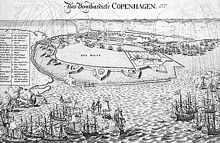
Siege of Copenhagen 1700
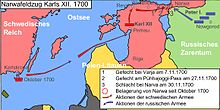
Narwa campaign of Charles XII.

Description of the campaigns during the first phase of the war from the outbreak of the war in 1700 to the turn of the war as a result of the Battle of Poltava in July 1709.

Blockade of the city of Riga by Polish and Saxon troops in 1700
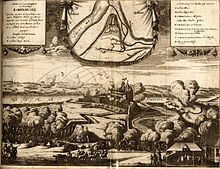
The Shelling of Kokenhusen Castle in Livonia by Saxon Troops (Autumn 1700); Contemporary Print
War of dethronement against August II. (1701–1706)
By the end of 1700, Charles XII had successfully defended Sweden and driven all enemy troops from Swedish territory. Instead of pursuing the defeated Russian army in order to destroy it completely and also force his opponent Tsar Peter I to make peace, the king now turned to his third opponent, the Saxon Elector and King of Poland, in order to wrest the Polish royal throne from him. There has been much speculation about the Swedish king's exact motives, and this decision of his has been almost unanimously criticised by later military historians as a gravely mistaken decision, since the opportunity was missed to finally destroy the defeated Russian army and thus force Russia to make peace. The decisive factor for the turn towards Poland was probably Charles XII's personal motives. As a convinced Lutheran, the Swedish king harboured a personal hatred for Augustus the Strong, who had deviated from the Lutheran faith of his ancestors for reasons of power calculation and converted to Catholicism in order to become King of Poland. Moreover, Charles XII saw Augustus the Strong as the real warmonger against Sweden. The Livonian noble opposition to the Swedish crown under Reinhold von Patkul had relied above all on Polish-Saxon support. In addition, the Swedish king fatally underestimated Russia's military potential and believed that he could defeat the Russian army anew at any time, as he had done at Narva in 1700. Karl considered the military development in the Baltic to be of secondary importance.
The Swedish king turned his main army towards the south and in the following 5 years of the War of Dethronement passed through almost the entire Polish territory. Alongside this, however, further battles for dominance in Courland and Lithuania took place between Swedish troops under the supreme command of Lewenhaupt and Russian units. An overlap between the two theatres of war in the Baltic and in Poland only occurred in 1705, when a Russian army that had marched into Courland in 1705 had to retreat before the approaching Charles XII without an open battle. In campaigns lasting years, Charles spent himself and the Swedish army in Poland and Saxony, while Swedish Livonia was devastated by Russian armies. The war in Poland only ended in 1706 with the Peace of Altranstadt, in which August II was forced to abdicate the Polish throne.
Occupation of the Duchy of Courland
August II now prepared himself for the Swedish offensive expected in the new year. The refusal of his Polish subjects to support the war financially and with troops proved to be a disadvantage. The Polish Diet of February 1701 only obtained the support of Augustus with a small auxiliary corps of 6,000 Poles and Lithuanians, too few for the upcoming battle against Charles. In response to the Swedish successes, August II and Peter I met in February 1701 in a completely changed situation to renew their alliance. Peter needed time to reorganise and rearm the Russian Tsar's army. August needed a strong ally at the Swedes' back. Tsar Peter promised to send 20,000 men to the Düna so that August could have a 48,000-strong army of Saxons, Poles, Lithuanians and Russians at his disposal to repel the Swedish attack in June 1701. Under the impression of the Swedish successes, both allies sought to withdraw from the war each on their own: Regardless of their agreement and without the knowledge of the other, they offered the Swedish king a separate peace. Charles XII, however, did not want peace and stepped up his preparations for the planned campaign against Poland. To this end, he had a total of 80,492 men raised for 1701. 17,000 men were assigned to cover the interior of the country, 18,000 men protected Swedish Pomerania, 45,000 men were distributed among Livonia, Estonia and Ingermanland. Most of the Swedish troops in Livonia were concentrated around Dorpat.
After the usual army parades, the Swedish advance via Wolmar and Wenden to Riga began on 17 June 1701. Karl planned to put his army across the Düna between Kokenhusen and Riga. The Saxons had suspected this approach and erected field fortifications at several crossing points along the Düna. Both armies faced each other for the first time on July 8/July 19 near Riga on the Düna. With 25,000 men, the Saxon-Russian army was slightly superior to the Swedes, who numbered about 20,000. This advantage was lost, however, because the Saxon commander-in-chief, Adam Heinrich von Steinau, allowed himself to be deceived by Swedish diversionary tactics and fragmented his units along the Düna. Thus the Swedish infantry managed to cross the wide stream and form a bridgehead on the riverbank held by the Saxons. The Saxon army suffered a defeat in the ensuing battle of the Düna, but was able to rally and retreat in an orderly fashion as far as Prussian territory. The Russian troops, equally shocked by the renewed defeat, retreated to Russia. All of Courland was thus open to the Swedish army. With his victorious troops, Charles occupied Mitau, the capital of the Duchy of Courland, which was under Polish feudal sovereignty.
Conquest of Warsaw and Krakow
The Polish-Lithuanian Republic protested against the violation of Polish territory by the Swedish advance into Courland, because it was not the Republic (represented by the Sejm) that was at war with Sweden, but only the King of Poland. When Augustus the Strong again offered negotiations, Charles XII's advisors recommended making peace with the King of Poland. The governor-general of Livonia, Erik von Dahlberg, went furthest in this, eventually even resigning in protest against his king's war plans. But Charles remained uncompromising and demanded that the Sejm elect a new king. This, however, was rejected by the majority of the Polish nobility.
In January 1702, Charles moved his army from Courland to Lithuania. On 23 March 1702, the Swedes left their winter quarters and invaded Poland. Without waiting for the planned reinforcements from Pomerania, Charles marched his army directly against Warsaw, which surrendered without a fight on 14 May 1702. The Polish capital was forced to pay a high tribute before Charles continued his march to Krakow. The fear that Sweden would seek territorial gains in Poland in a conceivable peace treaty now also prompted the Polish nobility to join the war.
Before Charles XII. occupied Warsaw, August II had moved to Krakow with the Polish Crown Army, about 8,000 strong, to join up with the 22,000-strong Saxon army that had been newly raised in Saxony. The Polish crown army under Hieronim Augustyn Lubomirski was poorly equipped, inadequately supplied with food and poorly motivated to fight for the Saxon king's cause. When the Polish-Saxon army of 24,000-30,000 men confronted the Swedes, who numbered only 12,000, south of Kielce, this circumstance facilitated a comprehensive victory for the Swedes in the Battle of Klissow on July 8/July 19. In the process, 2,000 Saxons were killed or wounded, and another 700 fell into Swedish captivity. The Swedes captured 48 cannons and suffered 300 dead and 800 wounded themselves. They also captured the whole of August's troop as well as 150,000 riksdaler and his silverware. The Swedes' low troop strength, however, did not allow them to pursue the defeated Polish-Saxon army, and so August was able to regroup the remaining units of his army in the eastern parts of Poland. His rapid retreat via Sandomierz to Thorn allowed Charles to occupy Krakow on 31 July 1702. Sweden now controlled the royal seat of Warsaw and the coronation city of Krakow. However, more than half of the Polish Empire remained in the hands of August II.
War in Courland and Lithuania
.png)
At the end of the 17th century, the Sapieha quickly became the most powerful dynasty in Lithuania, seeking to break Lithuania's union with Poland and claiming the throne for themselves. The electoral victory of August of Saxony as King of Poland in 1697 restricted the prerogatives of the Sapieha. A civil war broke out in Lithuania and Belarus, in which the Szlachta led by Oginski and Wiśniowiecki was victorious until 1700.
In addition to the war events in Poland, there was also fighting in Courland and Lithuania for supremacy in the Baltic. The victors of the previous Lithuanian-Belarusian civil war, the Oginski, had removed the Sapieha from all state offices by decree. The defeated former rulers now allied themselves with the victorious Swedes, while the Oginski or Count Grzegorz Antoni Ogiński called Peter I to their aid. Peter I signed an agreement with the Oginskis in 1702 for military aid. A fierce civil war broke out again. To protect Courland, a Swedish corps under the command of Carl Magnus Stuart had been left behind after the departure of the main army under Charles XII in January 1702. Due to a wound that would not heal, however, he left the actual command of the troops to Colonel Count Adam Ludwig Lewenhaupt. In Lithuania itself, under the command of Generals Carl Mörner and Magnus Stenbock, there was another Swedish detachment of several thousand men, large parts of which succeeded Charles XII in June 1702, leaving only a small force behind.
While the Sapieha, allied with Sweden, organised peasant troops to fight the Oginski confederacy in the Dnieper region of Belarus, the latter, with Russian support, ravaged the Sapiehas' lands. When the Sapiehas temporarily withdrew from Lithuania after the Swedes withdrew, Ogiński took advantage of the situation and attacked the Swedish troops in Lithuania and Courland from May to December 1702. His goal was to capture the fortress of Birze as a base for further ventures. In one of his attempts, Ogiński's army of 2500 Russians and 4500 Poles routed a 1300-strong Swedish detachment sent to dispose of the fortress. On 19 March 1703, the defeated Swedish division defeated the Russian-Polish army in the battle at Saladen. Ogiński then retreated to Poland to unite with August's troops.
Swedish conquest of western and central Poland
August II had once again offered the Swedes peace negotiations after the defeat at Klissow on 19 July 1702. He wanted to meet the Swedish demands as far as possible, with the sole aim of remaining King of Poland. Michael Stephan Radziejowski, Cardinal Archbishop of Gniezno and Primate of Poland-Lithuania, also made proposals for peace on behalf of the Republic of Poland. He offered Charles XII. Polish Livonia, Courland and a high war indemnity. Charles would only have had to renounce the deposition of the king, but he was not prepared to do so. So the war continued. After a delay of several weeks caused by a broken leg of Charles, the Swedes continued their advance along the Vistula. At the end of autumn 1702, Charles moved his troops to winter quarters at Sandomierz and Kazimierz near Krakow.
August II, forced to continue the war, had to build up an army again to halt the Swedish advance. He held an Imperial Diet in Thorn, where he was promised 100,000 men. To raise the funds for this, he travelled to Dresden in December.
In the first months of 1703, the war was at rest. It was not until March that Charles XII set off with his army in the direction of Warsaw, which he reached at the beginning of April. At the beginning of April 1703, August II. Dresden to begin a new campaign from Thorn and Marienburg. He had used the time to raise a new Saxon-Lithuanian army. When Charles learned that the enemy army was encamped near Pułtusk, he left Warsaw and crossed the Bug with his cavalry. On 21 April 1703, the Saxons were completely taken by surprise in the battle of Pułtusk. The victory cost the Swedes only 12 men, while the Saxon-Lithuanian army had to cope with 700 prisoners as well as several hundred dead and wounded. After the defeat at Pułtusk, the Saxons were too weak to face the Swedish army in the open field. They retreated to the fortress of Thorn. Charles XII then moved northwards to destroy the last remnants of the demoralised Saxon army. After months of besieging Thorn, he captured the city in September 1703. The Swedes captured 96 cannons, 9 mortars, 30 field serpents, 8,000 muskets and 100,000 thalers. Several thousand Saxons went into captivity. The capture of Thorn brought King Charles complete control of Poland. To preclude any future resistance from the city, which had withstood the Swedes for half a year, its fortifications were razed. On 21 November, the Swedes left Thorn for Elbing. The deterrent example achieved the desired effect, and under the impression of the truce of war that preceded it, many other cities submitted to the Swedish king in order to be spared in return for the payment of high tributes. Shortly before Christmas, Charles had his army take up winter quarters in West Prussia, as this region had so far remained untouched by the war.
The Confederations of Warsaw and Sandomir
After the disastrous campaigns of 1702 and 1703, August II's military situation became hopeless, his financial resources were exhausted, and his power base in Poland began to crumble. Under the impression of the country's economic decline, the Polish nobility split into different camps. In 1704, the pro-Swedish Confederation of Warsaw was formed and pushed for an end to the war. It was joined by Stanislaus Leszczyński, who led the peace negotiations with the Swedes from 1704. Since he won the confidence of their king, Charles XII soon saw Stanislaus as a suitable candidate for the planned new election of the Polish king.
In Saxony, too, there was resistance to the Elector's Polish policy. August introduced an excise tax to fill his war chest and to be able to arm the army. This turned the Saxon estates against him. In addition, he aroused the displeasure of the population through aggressive methods of recruiting recruits. With Russian support, however, he managed to raise an army of 23,000 Saxons, Cossacks and Russians once again. Lithuania, Volhynia, Red Russia and Lesser Poland continued to be loyal to the Saxon king, so August was able to retreat with his court to Sandomierz. There, parts of the Polish nobility had formed a confederation in his support, opposing the Swedish occupation of Poland and the new king demanded by Sweden. The Sandomir Confederation under the hetman Adam Mikołaj Sieniawski refused to recognise an abdication by August and the accession of Stanislaus Leszczynski. This did not mean a real balance of power, however, because the confederation had little military significance and its troops could at best disrupt the Swedes' supplies. Tsar Peter concluded an agreement with August II that enabled him to continue the war against Sweden on the territory of Poland-Lithuania. Then, in the autumn of 1704, a large Russian army moved into Belarus, remaining stationed in Polotsk for a long time and then capturing Vilna, Minsk and Grodno.
Election of a new King of Poland loyal to Sweden
At the end of May 1704, Charles XII set out from his winter quarters for Warsaw to protect the planned royal election. The army consisted of 17,700 infantry and 13,500 cavalry. After Charles' arrival in Warsaw, under the protection of the Swedish army, Stanislaus I Leszczyński was elected king on 12 July 1704 against the will of the majority of the Polish nobility.
After the election, Charles advanced with a strong army corps against the breakaway territories that refused to obey the new king. August did not recognise the election and evaded the advancing Charles with his army. When the Swedish army advanced as far as Jarosław in July, August took the opportunity to move back to Warsaw. Instead of pursuing him, Charles captured the poorly fortified Lemberg in an assault at the end of August. Meanwhile, August had reached Warsaw, where the newly elected king was also staying. In the city itself stood 675 Swedes and about 6000 Poles to protect the king, who was loyal to Sweden. Most of the Polish soldiers deserted, and the Polish king also fled the city, leaving the Swedes alone to resist. On 26 May 1704, the Swedish garrison had to capitulate to August II. After the capture of Warsaw, August moved to Greater Poland. The weak Swedish contingent there was then forced to withdraw.
Near Lemberg, Charles received news of the capture of Narva by Russian troops. However, he still ruled out a move to the north. After a two-week delay, the Swedish army returned to Warsaw in mid-September to retake the city. August did not risk a battle, but fled from his capital before Charles' arrival and placed General Johann Matthias von der Schulenburg in command of the Saxon army. He, too, did not dare to engage in open field battle and retreated to Posen, where a Russian contingent under the command of Johann Reinhold von Patkul had surrounded the city. After the renewed conquest of Warsaw, Charles had the Saxon-Polish army pursued. In the process, a Russian detachment of 2000 men was defeated in a skirmish, 900 Russians fell. The remaining Russians fought almost to the last man the following day. Despite the skilful retreat of the Saxons under Schulenburg, Charles caught up with part of the Saxon army just before the Silesian border. In the battle of Punitz, 5000 Saxons withstood four attacking Swedish dragoon regiments. Schulenburg succeeded in withdrawing his troops in an orderly fashion across the Oder into Saxony. Because of the exhausting marches, Karl had to move into his winter quarters as early as the beginning of November. He chose the district of Greater Poland bordering on Silesia, which had been largely spared by the war until then.
Development in Courland and Lithuania
After Lewenhaupt's victory the previous year, Jan Kazimierz Sapieha returned to Lithuania in the spring of 1704 and strengthened Lewenhaupt's position there. After Leszczyński's election as the new Polish king, Lewenhaupt had received orders from Charles XII to enforce the Sapiehas' claims in their homeland. Lewenhaupt invaded Lithuania with his troops from Courland, whereupon the supporters of August II led by Count Ogiński had to retreat. Lewenhaupt was able to win over the Lithuanian nobility to the Swedish side and persuade the Lithuanian Diet to pay homage to the new Polish king, but afterwards he had to return to Mitau, as a Russian army was approaching and threatening Courland.
The Russian army united with loyal Polish troops and moved to the fortress of Seelburg on the Düna, which was occupied by only a small garrison of 300 Swedes. Lewenhaupt immediately rushed to seize the besieged fortress. The Russian-Polish army then broke off the siege to confront the approaching enemy. On 26 July 1704, the two armies met at Jakobstadt, where the vastly outnumbered Swedish-Polish army of 3,085 Swedes and 3,000 Poles defeated a numerically superior army of 3,500 Russians and 10,000 Poles in the Battle of Jakobstadt. The Russian troops had to retreat. From the battlefield at Jakobstadt, Lewenhaupt first turned against the fortress of Birze, located between Riga and Mitau, which had been occupied by Ogiński's troops. The garrison of the fortress, consisting of 800 Poles, surrendered immediately and were given free leave. Lewenhaupt dismissed his troops to winter quarters for the rest of the year, which also gave the war in Lithuania and Courland a rest.
Coronation of the King loyal to Sweden in Warsaw
There were no warlike events in Poland in the first half of 1705. The Swedish army under Charles XII camped idly in the town of Rawitch, which was also the headquarters of the Swedes in Poland. It was decided that Stanislaus Leszczyński, elected the previous year, would be crowned Polish king in July 1705. For the Swedes, securing the succession to the throne was so important because only with their desired candidate could the peace negotiations with Poland, which had already begun, be concluded. The previous king, August II, was also prepared to negotiate peace, but with the hope of a candidate on the Polish throne who was more docile for their purposes, the Swedish position hardened until the Swedes saw the dethronement of the Wettin as the only way to conclude a peace in their favour.
Unlike the Swedes, August II did not remain inactive and, with Russian support, was once again able to raise an army to prevent the coronation of the Swedish counter-king. At the suggestion of Johann Patkul, he appointed his fellow Livonian Otto Arnold Paykull as commander, who advanced to Warsaw with 6,000 Poles and 4,000 Saxons. To ensure the safety of the heir to the throne, Charles XII had sent the lieutenant general Carl Nieroth to the capital with 2,000 men. On 31 July 1705, the two armies met near Warsaw in the Battle of Rakowitz, in which the Saxon-Polish army was defeated by the Swedish army, which was five times smaller. Lieutenant General Paykull fell into the hands of the Swedes along with his diplomatic correspondence and was taken to Stockholm as a state prisoner. There he impressed his judges by claiming that he knew the secret to making gold. But although he gave a sample of his alchemical art, Charles XII deemed the matter unworthy of further investigation and had him beheaded for treason.
As a result of the battle, Stanislaus Leszczyński was able to be crowned unhindered as the new Polish king in Warsaw on 4 October 1705. However, he remained completely dependent militarily and financially on his Swedish patrons and was still not recognised in all parts of the country. Only Greater Poland, West Prussia, Masovia and Lesser Poland submitted to him, while Lithuania and Volhynia continued to adhere to August II and Peter I. As a direct consequence of the royal coronation, the Kingdom of Poland concluded the Peace of Warsaw with Sweden on 18 November 1705 in the person of Leszczyński. The previous king of the country and Elector of Saxony, August II, did not accept this peace and declared that there was no longer war only between Sweden and Poland, but that there would continue to be war between Sweden and the Electorate of Saxony.
The war also continued in Courland and Lithuania. Due to Levenehaupt's successes the previous year, Peter I had instructed his marshal Sheremetyev to cut off Levenehaupt's 7,000-strong and fragmented army from Riga with an army of 20,000 men. To do this, the advance had to be kept secret for as long as possible in order to prevent the enemy forces from concentrating. However, this did not succeed, so Lewenhaupt was able to gather his troops in time. On 16 July 1705, Lewenhaupt deployed his entire army in battle formation against the advancing Russian army. After four hours of fighting, the Swedes won the Battle of Gemauerthof with a loss of 1,500 men, while the numerically superior Russian army lost 6,000 men. The Swedes' victory did not last long, however, for in September Peter sent another army, this time 40,000 strong. This time, the Tsar only allowed his army to march at night in order to maintain the secrecy of the operation for as long as possible. Nevertheless, Swedish scouts learned of the new Russian advance, so that Lewenhaupt, who had been promoted to lieutenant general, was able to gather his troops in and around Riga. After Peter I had been informed of this, he directed the planned advance towards the smaller fortresses of Mitau and Biskau instead of Riga. Since all Swedish troops were around Riga, the whole of Courland could be occupied by Russian troops.
Struggle for the recognition of the new king
→ Main article: Grodno campaign (1705/1706)
For the first time since the battle of Narwa, Charles XII marched with the Swedish main army into the Baltic to help the Swedish forces there who were under pressure. The starting point was Warsaw, where he had stayed throughout the autumn of 1705. Charles decided to force the still renegade territories to swear allegiance to the new king. At the end of 1705, the army began its advance across the Vistula and the Bug to Lithuania. In the autumn, Swedish reinforcements from Finland had brought Lewenhaupt's army, which had been assembled in Riga, to a strength of 10,000 men. The Russian forces in Courland now feared being heckled by Lewenhaupt's troops in Riga and the approaching Charles. After the fortifications in Mitau and Bauske had been blown up, they withdrew from Courland first to Grodno, so that Lewenhaupt could once again occupy Courland. After the Russians had left, the Lithuanians began to turn more and more to the new King of Poland, who was loyal to Sweden, which considerably reduced the burdens of the war for them. A reconciliation of the opposing Lithuanian noble families of the Sapiehas and the Wienowickis also succeeded. Since Count Ogiński's continued struggle on the side of August II was not successful anywhere, the Swedish party in Lithuania now finally gained the upper hand.
On 15 January (jul.), Charles XII's army crossed the Nyemen on its way to Grodno, where a 20,000-strong Russian army under Field Marshal Georg Benedikt von Ogilvy stood. This army had crossed the Polish border in December 1705 to join up with the Saxon troops. Charles had marched towards the Russians with the main part of his army of almost 30,000 men, but a battle did not take place, as the Russian troops did not want to get involved in a confrontation with the Swedish king and retreated to Grodno. Due to the cold, a siege was out of the question, so Charles merely had a blockade ring built around Grodno, cutting off the city and the Russian army from the supply of goods.
When August II saw that Charles XII was lying idle outside Grodno, he held a council of war which decided to take advantage of the king's absence to destroy a Swedish detachment under the command of Carl Gustaf Rehnskiöld further west. The latter had been left behind by Charles with over 10,000 men to protect Greater Poland and Warsaw. August wanted to move west, unite with all the Polish detachments on the way and then with the newly formed Saxon army in Silesia under the command of General Schulenburg, to attack Rehnskiöld's corps and march back to Grodno after a victory. On 18 January August bypassed the Swedish blockade to the west with 2000 men, united with several Polish troop contingents and on 26 January entered Warsaw for the second time. From there, after a short pause, he advanced further with his army, which in the meantime had grown to 14,000 to 15,000 men, to attack the Swedish corps. He also ordered General Schulenburg to take up with his troops the Russian auxiliary corps of 6,000 men lying nearby and to march to Greater Poland to unite with it. Rehnskiöld received news of the Saxon plan and hoped to avoid annihilation by engaging the enemy in combat while they were still separated. By pretending to retreat, General Schulenburg was actually induced to attack the outnumbered Swedes. Without reinforcements from August II's Polish army, Schulenberg's Saxon recruits suffered a crushing defeat at the hands of the storm-tossed Swedes at the Battle of Fraustadt on 13 February 1706. August II broke off his advance after this renewed setback, sent part of the troops back to Grodno and marched the rest to Krakow. The situation in Grodno became hopeless for the Russian army after the defeat at Vranov. They could no longer hope for relief, and the supply difficulties had worsened drastically in the meantime. In addition to the famine, diseases spread among the soldiers, leading to high casualties. After news of the defeat at Fraustadt reached Grodno, the Russian commander Olgivy decided to make a break for Kiev with the remaining 10,000 able-bodied men. They escaped the Swedish pursuers and managed to save themselves across the border.
Charles XII had marched as far as Pinsk in pursuit of the Russian army. From there, after a pause, he set out on 21 May 1706 to move into the south of Poland-Lithuania. The territories there still held to August and refused an oath of allegiance to King Stanislaus I. On 1 June, Charles moved into Volhynia. There, too, the new king loyal to Sweden had been recognised with military vigour. During the summer months there was also fighting. Several forays by the Swedes along the Russian-Polish border against Russian positions brought no decisive results. Based on the experience of the campaigns through Poland, which had served the purpose of asserting the legitimacy of the new king loyal to Sweden, Charles began to rethink his strategy. As long as the Swedish army was in place, the inhabitants took the enforced oath of allegiance. As soon as the Swedish army had left, however, they turned back to King August, who kept bringing in new troops from his retreat in Saxony. Due to the unsuccessfulness of his previous strategy, Charles now wanted to end the war by moving into Saxony.
Conquest of Saxony and abdication of King August II.
In the summer of 1706, Charles XII set out with his troops from eastern Poland, joined forces with Rehnskjöld's army and on 27 August 1706 entered the Electorate of Saxony via Silesia. The Swedes conquered the Electorate step by step and stifled all resistance. The country was rigorously exploited. August no longer had any troops worth mentioning since the battle of Fraustadt, and since his ancestral land was also occupied by the Swedes, he had to offer Charles peace negotiations. The Swedish negotiators Carl Piper and Olof Hermelin as well as Saxon representatives signed a peace treaty in Altranstädt on 24 September 1706, but it could only become valid when ratified by the king.
Although August wanted to end the state of war, he was also bound by pledges of alliance to Peter I, to whom he concealed the approaching peace with Sweden. On hearing of the Swedish advance into Saxony, the Russian army under Generals Boris Petrovich Sheremetev and Alexander Danilovich Menshikov had advanced from the Ukraine far into western Poland. Menshikov led an advance detachment in front of the main body of the Russian army and united in Poland with the remaining Saxon-Polish army under August II. Thus, under Russian pressure, August had to officially continue the fight and rather reluctantly fought a final battle against the Swedes at Kalisch with the united army of 36,000 men. In the battle of Kalisch, the combined Russian, Saxon and Polish forces were able to completely destroy the numerically outnumbered Swedish troops under General Arvid Axel Mardefelt, who had been left behind by Charles to defend Poland. In the process, General Mardefelt and over 100 officers (including Polish magnates) were taken prisoner. This, however, did not change the continuing Swedish superiority, so that August refused to annul the peace treaty and quickly returned to Saxony to seek a settlement with Charles. Thus, on 19 December, the Elector announced the ratification of the Altranstadt Peace Treaty between Sweden and Saxony, by which he renounced "forever" the Polish crown and dissolved the alliance with Russia. He also undertook to surrender the prisoners of war and defectors, namely Johann Reinhold von Patkul. Augustus the Strong had already arrested the Livonian, who had advised him to go to war, in December 1705. After he was handed over to the Swedes, Charles XII had him executed and quartered as a traitor.
For the Polish king Stanislaus Leszczyński, who was dependent on Sweden, the treaty did not improve his situation. He did not succeed in integrating his domestic enemies, and so he remained dependent on the protection of Swedish troops.
The Swedish advance into Saxony triggered international entanglements in 1706/07, for the occupation of an imperial territory was a clear breach of imperial law, especially since Charles XII was himself an imperial prince through his possessions of Swedish Pomerania and Bremen-Verden. Moreover, the Swedes had marched unasked through Silesia, which was Habsburg territory. However, another imperial war could not be enforced due to the simultaneous war with France. From the point of view of the Viennese Court, it was also important to prevent Charles from allying with the rebellious Hungarians or invading the Habsburg hereditary lands and thus creating a new constellation as in the Thirty YearsWar.
The danger that the Great Northern War would mix with the fighting in the War of the Spanish Succession, which was taking place in Central Europe at the same time, was great at this time. Both warring sides therefore endeavoured to win the King of Sweden as an ally or at least to keep him out of the conflict. Thus, in April 1707, the allied commander of troops in the Netherlands, John Churchill, Duke of Marlborough, visited the Swedish camp in Saxony. He urged Charles to turn his army back to the east and not to advance further into imperial territory. The Habsburg Emperor Joseph I also asked Charles to stay out of Germany with his troops. To this end, the Emperor was even prepared to recognise the new Polish king and to make concessions to the Protestant Christians in the Silesian hereditary lands, as finally agreed on 1 September 1707 in the Altranstadt Convention, in which, among other things, permission was granted to build so-called churches of grace. Charles had no interest in interfering in German affairs and preferred to move against Russia again.
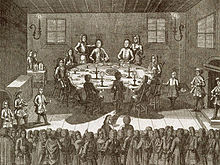
Official lunch of the participants after the signing of the Treaty of Altranstadt on 7 December 1706. (jul.) Engraving

The handing over of the keys of the city of Leipzig to King Charles XII. Copper engraving, early 18th century. Swedish troops were quartered in many towns in Saxony. Unlike during the Thirty Years' War, there are said to have been no riots against the civilian population.
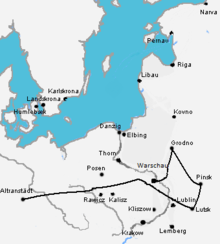
Campaign of Charles XII. End of 1705 until end of 1706
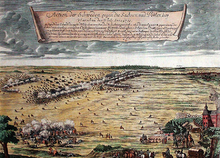
Battle at Rakowitz on 31 July 1705

Battle of Jakobstadt
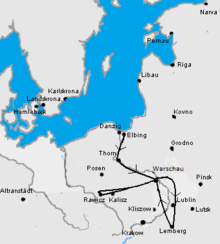
Campaigns of Charles XII from May 1704 to December 1705
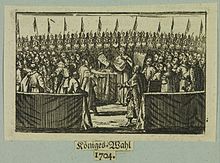
On 12 July 1704, against the will of the majority of the Polish nobility, Stanislaus I Leszczyński was elected king under the protection of the Swedish army.
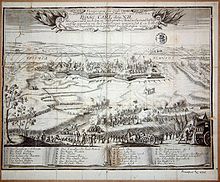
"Prospect of the City of THORN So Anno 1703 im Majo von Ihro Königl. Mayten von schweden KÖNIG CARL den XII blocquirt".
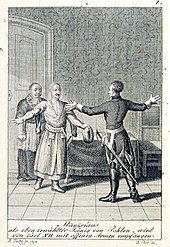
Charles XII receives Stanisław Leszczyński (1677-1766) in 1704, copperplate engraving by Daniel Nikolaus Chodowiecki (1726-1801)

Battle of Pułtusk 1703
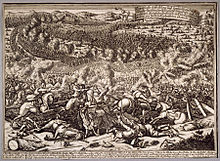
Copper engraving depicting the Battle of Klissow between Sweden and Saxony on 19 July 1702
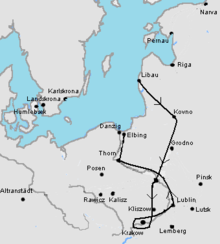
Campaigns of Charles XII from his winter camp in Courland at the beginning of 1702 to the start of the winter camps in West Prussia at the end of 1703
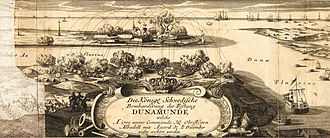
Bombardment of Dünamünde Fortress by Royal Swedish Troops in 1701

Camp of the Polish and Swedish troops along the Düna, 1700
War in the Swedish Baltic Provinces (1701-1707)
→ Main article: Livonian-Estonian theatre of war
Far from the fighting in Poland, Russia conquered the Swedish Baltic provinces step by step after the defeat at Narwa. Since the main Swedish army was tied up in Poland, far too few Swedish forces had to protect a large territory. Due to the numerical superiority of the Russians, they succeeded less and less. The Russian forces were thus able to get used to the Swedish war tactics with relative ease and develop their own war capabilities, with which they then inflicted a decisive defeat on Charles in the Russian campaign.
Russian war plans after the battle of Narva
After the victory in the battle of Narva at the end of November 1700, Charles XII had moved south with his main army to lead the fight against August II. He entrusted the supreme command of the Swedish Baltic possessions to Major General Abraham Kronhjort in Finland, Colonel Wolmar Anton von Schlippenbach in Livonia and Major General Karl Magnus Stuart in Riga. The Swedish warships in Lake Ladoga and Lake Peipus were commanded by Admiral Gideon von Numers. The Russian army was no longer a serious opponent at that point. Because of the resulting certainty of victory, Karl rejected Russian peace offers. The tactical superiority of the Swedes over the Russians had also become entrenched as a prejudice in the mind of Charles, who was so convinced of the insignificance of Russian striking power that he continued to concentrate his war effort on the Polish theatre of war even when a large part of Livonia and Ingermanland was already under Russian control.
However, the shift of the Swedish main force to the Polish theatre of war increased Peter I's chances of leading the war to a more favourable course and of conquering the desired Baltic access for Russia. Tsar Peter took advantage of the withdrawal of the Swedish army and allowed the remaining Russian forces to resume their activities in the Swedish Baltic provinces after the disaster of Narva. The Russians' war strategy was to wear down the enemy. This was to be achieved through forays and constant attacks, combined with the starvation of the population by destroying villages and fields. At the same time, the Russian soldiers were to be accustomed to Swedish war tactics with their fierce attacks in battle through constant fighting.
Tsar Peter used the time gained by the absence of the Swedish army to rearm and reorganise his army at enormous expense. He appointed foreign experts to train the troops - equipped with modern weapons - in the methods of Western European warfare. In order to quickly rebuild the artillery lost at Narva, he had church bells confiscated to have cannons cast from them. He had hundreds of gunboats built on Lake Ladoga and Lake Peipus. By the spring of 1701, the Russian army again had 243 cannons, 13 howitzers and 12 mortars. Strengthened by new recruitments, it again consisted of 200,000 soldiers in 1705 after the 34,000 remaining in 1700.
In order to support his war plans diplomatically, the Tsar also had a negotiator sent to Copenhagen to persuade Denmark to invade Scania, in parallel with the declarations of support to August II. Since the Swedish Imperial Council had a force advance to the Sound, the alliance plans failed and the Danes postponed their attack until later.
The Swedish forces in the Baltic under Colonel von Schlippenbach were only very weak and, moreover, separated into three autonomous corps. Each of these corps was too weak on its own to be able to successfully confront the Russian forces, especially since they were not led in a coordinated manner. Moreover, these troops were not composed of the regular regiments, but of newly recruited recruits. Swedish reinforcements were primarily supplied to the Polish theatre of war, so that one strategically important point after another could be conquered by the Russian army.
Dismantling of the Livonian army
After the withdrawal of their king with the main army, the Swedes nevertheless remained offensive for the time being, at least while Russia was still weakened after the defeat at Narva. In order to eliminate the only remaining Russian trading port in the White Sea, seven to eight Swedish warships made an advance from Gothenburg to Arkhangelsk in March 1701. The venture affected English and Dutch trading interests with Russia. Both nations reported the departure of the Swedish expeditionary fleet to their Russian partner. Peter then had the city's defences reinforced. When the Swedish fleet reached the White Sea, two frigates ran onto a sandbank and had to be blown up. The attack on Arkhangelsk did not promise success because of Peter's precautions, so the fleet sailed home again after destroying 17 surrounding villages.
In mid-1701, first Swedish and then Russian forces conducted forays into Ingermanland and Livonia and marched into each other's territory, where they engaged in several skirmishes. The Russian forces had recovered sufficiently to be capable of limited offensives. From the Russian headquarters at Pskov and Novgorod, a force of about 26,000 men moved south of Lake Peipus into Livonia in September. In the subsequent campaign in September 1701, the Swedish general Schlippenbach, with a division of only 2,000 men, succeeded in defeating the Russian main army of about 7,000 men under Boris Sheremetyev in two encounters at Rauge and Kasaritz, with the Russians losing 2,000 soldiers. Nevertheless, Russian army units continued to make limited attacks on Livonian territory, which the outnumbered Swedes had less and less to counter.
During the second major invasion of Livonia under the leadership of General Boris Sheremetyev, Russian forces defeated a Swedish-Livish army of 2,200 to 3,800 men under the command of Schlippenbach for the first time at the Battle of Erastfer on 30 December 1701. Swedish losses were estimated at about 1,000 men. After the victorious Russians had plundered and destroyed the area, they retreated again, as Sheremetyev feared an attack by Charles XII, who was in Courland with a strong army force. From the Swedish point of view, the unequal balance of power made a successful defence of Livonia seem increasingly unlikely, especially as the previous disdain for the Russians hardly seemed justified after their recent victory. Charles nevertheless refused to return to Livonia and merely sent some supplementary troops.
When Charles marched from Warsaw to Krakow in the summer campaign of 1702, thus exposing the northern theatre of war, Peter again saw the opportunity for an invasion. From Pskov, an army of 30,000 men crossed the Swedish-Russian border and reached Erastfer on 16 July. There, on 19 July, the Russian army scored decisive victories against the Swedes, who numbered about 6,000 men, in the battle at Hummelshof (or Hummelsdorf), near Dorpat and at Marienburg in Livonia. According to Swedish figures, 840 of their own dead and 1,000 prisoners died in the battle itself and another 1,000 during the subsequent pursuit by the Russians. The battle marked the end of the Livonian army and the starting point of the Russian conquest of Livonia. As the remaining Swedish forces were too weak to face the Russians in an open field battle, Wolmar and Marienburg as well as the rural areas of Livonia fell into Russian hands before the end of August. Extensive devastation and destruction of Livonia followed. After the looting, the Russian army retreated to Pskov without occupying the conquered territory.
Conquest of Newaumland and Ingermanland
With the Livonian army effectively annihilated, Peter could set about creating the territorial conditions for his real war aim, the establishment of a Baltic port. After the victorious campaign, Field Marshal Boris Sheremetyev led the Russian army northwards towards Lake Ladoga and the Newaum Land, as this was where the Baltic Sea reached furthest into Russian territory and seemed suitable for the establishment of a harbour. This area was secured by the Swedish fortresses of Nöteborg and Kexholm as well as a small navy on Lake Ladoga, which had so far prevented all Russian advances. To counter this threat, Peter I had a shipyard built on the south-eastern shore of Lake Ladoga near Olonetz, which subsequently built a small Russian war fleet. With it, the Swedish ships could be pushed back to the fortress of Vyborg and further actions of the Swedes on the lake could be prevented. The Russians then turned their attention to the fortress of Nöteborg, which was situated on an island in the Neva at the mouth of Lake Ladoga and protected the river and the lake. At the end of September, the siege of Gothenburg began by a 14,000-strong Russian army led by Field Marshal Sheremetyev. The Swedes attempted to seize the fortress from Finland, but a Swedish reinforcement of 400 men was repulsed by the besiegers. On 11 October 1702, the Russians captured the citadel, which was last held by only 250 men. By capturing Gothenburg, Peter now controlled Lake Ladoga, the Neva, the Gulf of Finland and Ingermanland. Because of the strategic importance of the fortress, the Tsar changed its name to Schlüsselburg.
Peter's next move was the siege of Nyenschanz, a viable trading post and strategically important point at the mouth of the Neva into the Gulf of Finland, in March 1703. 20,000 Russian soldiers attacked the Swedish fortress. They began the siege and bombardment of the fortress. On 4 May, Boris Sheremetyev's troops, with the help of the new Russian navy, succeeded in taking the fortress, which was manned by 600 men. On 18 May, Russia won its first victory on water. Eight Russian rowing boats under the command of Peter I succeeded in defeating two Swedish ships in a sea battle at the mouth of the Neva.
With the Neva now completely controlled by Russian forces, Tsar Peter began building a fortified city in the marshy river delta in 1703, which was to become the new Russian capital in 1711 under the name Saint Petersburg. However, the new city needed protection. By occupying and fortifying Kotlin and, opposite it in the sea, building Kronstadt, the deep-going Swedish warships were made unable to penetrate from the sea. At the same time, the Tsar had the fleet enlarged in order to be superior to the Swedes at sea as well. Russia already had a war fleet of 40 ships in the Baltic Sea in the spring of 1704.
The rest of Ingermanland, including Jaama and Koporje, could also be occupied by the Russians within a few weeks after the capture of Nyenschantz by a Russian infantry command under Major General Nikolai von Werdin, as the Swedes did not have any significant troops or fortresses there. Especially in the north, the Finnish fortresses of Viborg (Viipuri) and Kexholm (Käkisalmi) were too close to the conquered territories. In July 1703, therefore, the first Russian attack on Finland took place, with the fortress of Viborg as the target. This was to be attacked on the sea side by the rowing fleet and on the land side by a siege corps under Menshikov. On the way, the Russian forces were opposed by a Swedish-Finnish contingent at Sestrorezk (→ Battle of Systerbäck), which, however, had to retreat to Vyborg after a series of fierce battles. Fearing a landing of Swedish forces, however, the siege plans were abandoned and the Russian forces ordered back.
After the Russian corps returned from Finland, Peter marched it to Livonia and Estonia to support the hard-pressed Polish King August II. Instead of besieging the Swedes' weakly garrisoned fortresses, the Russians were content to devastate the country.
Consolidation of the Russian position in the Baltic States
Even after the Russian successes in the Neva region, Charles was not prepared to reinforce the Livonian forces or to intervene personally in this theatre of war, although he had taken up his winter quarters in nearby West Prussia at the beginning of 1704. Thus, on his orders, all levies in the Swedish heartland had to be led to Poland, and in July 1704 the Swedish king denuded Livonia even further when he moved 30,000 men to Warsaw to secure the election of his favourite as Polish king.
The fleet equipped by Peter I, which was directed against Swedish merchant shipping, was likewise only allowed to be fought by a few frigates. In order to disturb the plans for a new Baltic port of the Russians, a small Swedish fleet with one ship of the line, five frigates and five brigantines sailed to the Gulf of Finland after the winter, with the mission to destroy the Russian fleet and the new city in the Neva marshes. With 1000 men reinforcements from Viborg, an attack was to take place on land and at sea. However, after an initially successful landing on the fortified island of Kronstadt, the venture had to be abandoned due to stubborn resistance and the fleet sailed back.
Further battles were fought on Lake Peipus, whose mastery was a prerequisite for the conquest of Livonia. Here, the Swedes initially still dominated, having 14 boats with 98 cannons at their disposal. To counter this, the Russians built a number of boats during the winter months of 1703/04. At the beginning of May 1704, in the battle on the Embach, they succeeded in completely destroying the Swedish fleet. By controlling the lake, the Russian forces could now also be supplied via inland waters for the further campaigns of conquest.
Already in the summer of 1704, a Russian army under the command of Field Marshal Georg Benedikt von Ogilvy (1651-1710), was sent from Ingermanland to conquer Narva. At the same time, another army advanced against Dorpat. The aim of these operations was to capture these important border fortresses, thereby protecting Ingermanland, which had been conquered the previous year with its planned capital, and to conquer Livonia. An attempted Swedish relief under Schlippenbach with 1,800 remaining soldiers failed with the loss of the entire force. At the beginning of June, Dorpat was surrounded, and on 14 July 1704 the city fell into Russian hands. Already in April, Narva had been surrounded by 20,000 Russians with Peter I present. Three weeks after Dorpat, this fortress also fell on 9 August after a fierce assault and heavy fighting in the city. In the conquest of Narwa, 1,725 Swedes were taken prisoner.
Unsuccessful Swedish attacks on St. Petersburg
After the successes of the previous years, Russia remained on the defensive in 1705 and concentrated on securing the conquests. The Swedes, on the other hand, went on the offensive after being startled by the rapid progress in the construction of St. Petersburg. To this end, 6,000 recruits were sent to the Baltic provinces to reinforce the forces. A first attack by Swedish troops against the newly fortified Kronstadt in January 1705 ended essentially without results. In the spring, a fleet of 20 warships sailed from Karlskrona to Viborg and then to Kronstadt. The landing venture failed, as it had the previous year, with the Swedes lamenting several hundred casualties. A third landing attempt on Kronstadt failed on 15 July with the loss of 600 Swedes. Until December, the Swedish squadron cruised the Gulf of Finland and interrupted the trade in goods. However, disunity was already evident among the regional Swedish commanders, who were prone to uncoordinated solo actions, which the Russians had little trouble repelling.
In 1706, only a few battles took place in the Swedish Baltic provinces. In the first half of the year, Russian troops were deployed in the Polish theatre of war to support the hard-pressed King August II and to bind Charles XII in Poland. In the north, Peter I therefore remained defensive. The Swedish forces were not strong enough for offensive undertakings. Apart from a few forays into Russia, a renewed fleet advance with 14 warships was made to St. Petersburg, but again without results. Vyborg, from where Petersburg had been attacked several times, was briefly besieged by a 20,000-strong Russian army from 11 October 1706, but this too was unsuccessful. Nevertheless, by 1707 only a few main towns and fortresses in the Baltic were still in Swedish hands, including Riga, Pernau, Arensburg and Reval. Meanwhile, Charles' expected attack on Russia led to a pause in this theatre of war.
Russian victories had so far always been secured by clear numerical superiority. Tactics focused on the enemy's weak points with attacks on isolated Swedish fortresses with small garrisons. In the beginning, the Russian army still avoided attacking larger fortresses. The planned use of scorched earth tactics was a hallmark of warfare on the part of the Russians. Their aim was to make the Baltic States unfit as a Swedish base for further operations. Numerous inhabitants were abducted by the Russian army. Many of them ended up as serfs on the estates of high Russian officers or were sold as slaves to the Tatars or the Ottomans. The Russian army had gained in self-confidence through the successful operations in the Baltic. They proved that the Tsar's army had developed effectively in just a few years.
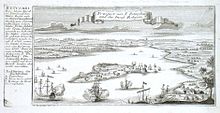
The newly founded St. Petersburg is only dimly visible in the distance. The depiction essentially shows a sea battle between the Swedish and Russian fleets off the island of Kotlin (Retusari). The Russian ships have gathered in the shelter of the fortress of Kronstadt (here called Cronschantz), the Swedes are attacking from the sea.

Illustration of the Newastrom with the newly founded city of St. Petersburg and the destroyed fortresses of Nöteborg and Nytenschantz.
.jpg)
Copper engraving of the siege of Narva Fortress by Russian troops

Leaflet on the conquest of Nöteborg (Schlisselburg) on the Neva and Lake Ladoga by the Russians, 1702
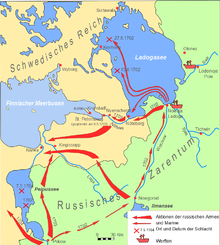
Russian advances into Ingermanland from 1700 to 1704

Siege of the fortress of Schlüsselburg (Nöteborg), 11 October 1702
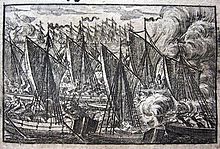
Swedish and Russian ships during the battles on Lake Ladoga in 1702

The Swedish Possessions in the Baltic States

Russian Field Marshal Boris Petrovich Sheremetev made a decisive contribution to Russian success with his victories against the Swedes.
The Turn of the War (1708-1709)
→ Main article: Charles XII's Russian campaign
With the Peace of Altranstädt, Charles XII had succeeded in persuading August II to abdicate the Polish throne after six long years of war. However, the success was marred by the fact that in the meantime the majority of the Swedish Baltic provinces were in Russian possession. Moreover, in 1706 a Russian army had invaded and occupied western Poland. During his march to Saxony, Charles had promised the worried Western European great powers not to interfere with his army in the War of the Spanish Succession, but to turn back to the East. Tsar Peter, Charles' last opponent, was therefore to be eliminated by a direct campaign on his capital Moscow. However, this turned out to be extremely unfavourable for the Swedes, as the Russian forces consistently used scorched earth tactics and thus caused supply difficulties for the Swedish army. Charles tried to counter these difficulties by moving into the Ukraine in order to be able to attack Moscow from the south. In doing so, he suffered a decisive defeat at Poltava in 1709, which spelled the end of the Swedish army in Russia. On hearing of the defeat of the hitherto practically undefeated Swedish king, Denmark and Saxony re-entered the war, while Charles, cut off from the motherland, veered south to the Ottoman Empire, where he spent the next few years in forced exile. A direct Danish invasion of southern Sweden failed, however, preventing a quick Allied victory and prolonging the war.
The Russian Campaign of Charles XII.
Charles' main goals after the Peace of Altranstädt were to liberate the occupied territories in the Swedish Baltic provinces and to conclude a lasting peace that would secure Sweden's position of great power. Therefore, in February, June and August 1707, he rejected several peace offers from the Tsar in Altranstädt, because he considered them to be a deceptive manoeuvre and only wanted to make peace with Peter I on his own terms. In fact, Russia was willing to make peace and would have been satisfied with Ingermanland. However, the continuation of the war was forced upon it by the Swedish king.
Charles XII hoped to achieve his war aims without turning the Swedish Baltic provinces into a battlefield. For this reason, an advance on St. Petersburg was ruled out from the outset. Instead, Charles wanted to manoeuvre the Russian army out of Poland to avoid further devastation of the country, which was now allied with Sweden. From the Russian border, the Swedish army was then to advance directly against Moscow, while at the same time the allied Ottomans advanced an attack on the Russian southern border.
In September 1707, the long prepared campaign against Russia began. The main Swedish army consisted of 36,000 experienced and rested soldiers, newly clothed and equipped with new weapons. The Swedish war chest had grown by several million thalers. The advance was to be made directly via Smolensk. On the Russian side, it was hoped that Menshikov's army, still in Poland, could hold off Charles' advance long enough for Tsar Peter to organise defences along the Russian border. Holding Poland, however, was not the intention. Instead, Menshikov's retreating Russian army was to adopt a scorched earth policy, depriving the advancing Swedish army of its supply base. On 7 September 1707, the latter crossed the Polish border at Steinau an der Oder. Menshikov's army avoided battle and retreated from the western part of Poland towards the east behind the Vistula. On the retreat, Menshikov had villages along the way burned, wells poisoned and all stores destroyed. At the end of October 1707, because of the muddy period that began in the autumn, Charles had his army hold east of Posen, where new recruits increased the Swedish forces to a strength of 44,000 men. After the frost had made the roads passable again and the rivers had frozen over, the Swedish army crossed the frozen Vistula in the last days of 1707 after four months of rest. Menshikov again avoided confrontation and retreated further. Instead of following the trail devastated by the Russian army, the Swedes marched through Masuria, which was considered impassable, thus bypassing the Russians' prepared defensive lines.
The direct advance on Moscow fails
In mid-January 1708, the Swedish army left Masuria behind and reached Grodno on 28 January 1708. Tsar Peter, who met with Menshikov not far from the town, considered the strength of the Russian army too small to be able to stop the Swedish army there and ordered a further retreat to the Lithuanian-Russian border. The Swedish advance continued until early February, when Charles XII's army moved into winter camp near the Lithuanian town of Smorgon. During this stay, Charles met with General Lewenhaupt. The effects of the Russian tactics were already making themselves felt in the form of supply shortages that threatened the further advance. Thus Karl and Lewenhaupt agreed that the latter would not join Karl's main army with the 12,000-strong Livonian army and a supply train until the middle of the year. The shortage of supplies forced the Swedish army to move to Radovskoviche near Minsk in mid-March, where the supply situation was less precarious. The army stayed there for another three months to prepare for the upcoming campaign. To support the Polish King Stanislaus I Leszczyński during Charles' absence, 5,000 men were detached and sent back, reducing the army to 38,000. The Swedish army was now spread out between Grodno and Radovskoviche, while the 50,000-strong Russian army had positioned itself along the line from Polozk on the Düna to Mogilev on the Dnepr. In addition to Sheremetev's protection of Moscow, the Russian army also sought to counter a possible threat to St. Petersburg, which led to a greater disaggregation of forces. Charles rejected a proposal by his advisor Carl Piper to direct the further advance towards St. Petersburg and thus secure the Livonian provinces, and decided to continue the march on Moscow. After the start of the summer campaign on 1 June, the Swedish army crossed the Berezina on 18 June. The Russian forces were able to evade an attempt by the Swedes to bypass them and retreated behind the next river barrier, the Drut. On 30 June, near the village of Halovchyn, Charles reached the Vabitch, a branch of the Drut. The main defensive line of the Russian army was located there, and a battle ensued. In the Battle of Golovchin on 14 July 1708, the Swedes defeated the 39,000-strong Russian army under Sheremetev, who, however, was able to withdraw his troops in good order. The victory is classified as a Pyrrhic victory for the Swedes, as many of the 1,000 wounded died due to inadequate medical care. The battle itself was not decisive for the war, although the Swedes were able to overcome the north-south river barriers and the road to Moscow was open.
In order to await the arrival of General Lewenhaupt with the reinforcements from Livonia and the urgently needed supply trains, Karl had the advance of the main Swedish army stopped at Mogilew. Lewenhaupt had indeed set out from Riga at the end of June with 13,000 reinforcements and 16 cannons, but bad weather delayed his advance. When the main Swedish army crossed the Dnieper in the first week of August, Lewenhaupt's army had still not arrived. Karl now marched southeast to attract the attention of the Russians and to protect the supply army from attack. On 21 August, the Swedes reached Chemikov on the river Sosh, where they held for another week. When Charles turned his advance north again on 23 August, the way to Smolensk was clear, since Peter I had left his position at Horki because of this advance and followed him.
Peter I had to march his troops north again to block the Swedish advance. When the Swedes reached Moljatitschi, they found a considerable number of Russian army forces in front of them, blocking the way to Smolensk. In the ensuing engagement, the outnumbered Russians again suffered higher casualties, with 700 dead compared to the Swedes' 300. A possible engagement with the main Russian army did not materialise because the Russians retreated as Karl brought in reinforcements. The encounter at Malatitze was nevertheless significant, because there the Russians finally demonstrated their increased morale and skill in battle. In the meantime, the Tsar's troops had reached at least the level of the Saxons, as a Swedish commander noted after the battle:
"The Swedes must concede to the Muscovites that they have learned their lesson, much better than they did in the battles at Narva or Fraustadt, and that they are equal, if not superior, to the Saxons in terms of discipline and courage."
- Jeffereyes
The Swedish supply army is destroyed
Peter maintained his strategy of not facing a decisive battle; his army retreated into the forests. On 4 September, Charles continued his advance and reached Tatarsk and Starishi. There, however, he had to admit his hopeless situation when food supplies reached a critical point and scouts reported that there was nothing but devastated land ahead. Desertions increased and news of Lewenhaupt's supply column was still not forthcoming. Finally, the Swedish king decided to break off the march on Moscow. His main aim now was to keep his army alive, and so on 15 September he swung south to the regions that had not yet been devastated.
When Charles left Tatarsk in mid-September, Lewenhaupt's supply army was still 80 miles away from the main Swedish army. Peter planned to use the gap between the two armies and put General Sheremetev in command of the main Russian army to follow Charles' army. Together with his closest confidant Menshikov, whom he had elevated to Duke of Ingermanland after the victory at Kalish, the Tsar himself took command of ten battalions of his most experienced infantry, ten dragoon regiments and four batteries of mounted artillery, together 11,625 men. Lewenhaupt's force consisted of 7,500 infantry and 5,000 cavalry accompanying a supply train of nearly 1,000 wagons. On 18 September, Lewenhaupt reached the Dnepr. The crossing of the river dragged on for a whole week, during which the Russians approached the Swedes, finally giving chase. On 27 September, the Swedes were caught up near the village of Lesnaya. In the battle of Lesnaya they lost their entire supply train, as well as 607 horsemen, 751 dragoons and 4449 infantry, of whom 3000 men were taken prisoner. Lewenhaupt led the remaining remnants to the main Swedish army ten days later, and so on 6 October the king received very different news from his supply train than he had hoped.
Far away, another Swedish advance was defeated by Russian forces at the same time. A Swedish force of 12,000 men was to conquer Ingermanland from Finland and burn down the new Russian city of Saint Petersburg. However, due to the strong defences of the city, the Swedes had to abandon the plan and retreat to Vyborg with the loss of 3,000 men.
Charles XII moves south to the Ukraine
Charles XII's goal of marching from Severia along the Strait of Kaluga to Moscow as soon as the army's supply situation had improved was no longer achievable due to the disaster at Lesnaya. Charles therefore resorted to a new strategy: he had already been in contact with the hetman of the Ukrainian Cossacks, Ivan Masepa, for some time. In the autumn of 1707, the Bulavin uprising of the Cossacks and peasants had broken out in the Don region, which was directed against the tsar's rule and rigorously put down by Peter I. Masepa was in contact with the tsar. Masepa had fallen out of favour with the Tsar; he considered this a violation by Russia of the Treaty of Pereyaslav. Since then, he sought a way to free Ukraine from Russia's grip. To this end, he promised the Swedish king that he would support him with an army of 100,000 men if the Swedes advanced into Ukraine. Charles XII then marched into Ukraine against the advice of his generals. But the expected reinforcements from the Cossacks failed to materialise; the Russians had sent an army under General Menshikov, whose troops occupied Masepa's capital, Baturyn, and unceremoniously killed many of his supporters, including 6,000 to 7,500 civilian casualties. Thus Masepa was only able to provide a small part of the men he had promised, 3,000 at first, later 15,000. Karl spent the winter in the Ukraine, still confident of achieving his goals the next year. On 23 December, a Russian battalion confronted the Swedes at Weprik on the Psel, holding out against the attackers until 7 January. At the end of January 1709, he continued his march to the south. However, the winter of 1708/09, the most severe of the century, had a devastating effect on the Swedes.
The disaster at Poltava
Thus, at the beginning of the spring of 1709, fewer than 30,000 men with a few cannons, just under half of the Swedish army, were ready for action in Russia. Especially the soldiers recruited in Germany had not been able to cope with the cold. They were supported by the Zaporozh Cossack units, which forced Tsar Peter to divide his forces. Despite the strained supply situation, Charles decided to lay siege to the city of Poltava, a supply base with large stocks of gunpowder and other supplies. He blockaded the city in early April 1709 with 8,000 of his soldiers, expecting a quick surrender. However, the Russian garrison under Colonel A. Kelin was supported by Ukrainian Cossacks and the local population and held out for 87 days. After Tsar Peter had defeated the Zaporozh Cossacks, he turned to Poltava with his total army of 60,000 men to sack the besieged city. They crossed the river Vorskla and set up a fortified camp a few kilometres north of the city. When the Russian command learned of the difficult situation of the Swedish army, the Tsar abandoned his evasive policy. Charles XII, who had been wounded in a reconnaissance operation on 28 June Reg, decided to forestall the impending attack by assaulting the fortified camp. In order to concentrate all forces on this task, Lewenhaupt demanded that the siege be abandoned, but the king refused and allowed Poltava to remain under siege. In the actual battle, therefore, only 20,000 men were deployed under Field Marshal Rehnskiöld. Since there was a lack of gunpowder, the soldiers had to go into battle with bayonets fixed and mostly unloaded muskets. Only 4 of 32 cannons could be used for the attack. Thus, on 8 July 1709greg. in the Ukraine, the decisive battle of Poltava took place. A surprise attack was intended to throw the Russians into confusion and disintegration. But after the Swedish raid met with only very limited success, the Russians engaged in open field battle, in which they inflicted a crushing defeat on the Swedes thanks to their superior strength. Many Swedish officers, including Field Marshal Rehnskiöld, fell into Russian captivity.
After the battle, the retreating army, consisting of only about 15,000 men and 6,000 Cossacks, gathered in the camp at Pushcarivka. After reorganisation and refreshment, the army was to be led back to Poland on a southern line of retreat through Ottoman territory. On the very day of the battle, the soldiers marched south along the Vorskla River. On 10 July, the army arrived at Perevolochna at the confluence of the Vorskla and Dnepr rivers. It was discovered that there were neither bridges nor fords there and the few boats available were not sufficient to evacuate the entire Swedish army.
The Swedish headquarters now decided that the wounded and an escort of Swedes and Cossacks should cross the Dnieper and move into Ottoman territory. The army, on the other hand, was to march back along the Worskla, swing south to the Crimea and rejoin the king there. In the night of June 30/July 11, 1709greg, the king crossed the river with Ivan Masepa, his companion Kost Hordijenko, 900 Swedes and 2,000 Cossacks. The army, now under the command of General Lewenhaupt, prepared to march the following morning. At eight o'clock, however, a Russian unit of 6000 dragoons and 3,000 Kalmyks arrived under Menshikov, who had still been promoted to field marshal on the battlefield of Poltava. Lewenhaupt immediately began negotiations and a surrender was agreed upon, although the Swedes outnumbered the opposing Russian troops by almost double. At 11 o'clock on the morning of June 30/July 11, the Swedish army surrendered with about 14,000 soldiers, 34 guns and 264 flags. Most of the remaining Cossacks fled on horseback to escape punishment as traitors. In total, nearly 30,000 Swedes went to Poltava as Russian prisoners of war, including 2,300 officers. Only the most distinguished were allowed to live in Moscow, like General Lewenhaupt and State Councillor Piper, who never saw their homeland again.
The troops around King Charles reached the Bug on 17 July, where the Pasha of Ochakov granted permission to enter the Ottoman Empire. A rearguard of 600 men did not make the crossing and was caught up and cut down by 6,000 Russian horsemen north of the Bug. Thus ended Charles' Russian campaign with a catastrophic defeat that became the decisive turning point of the entire war.
Renewal of the Nordic Alliance
After the defeat at Poltava, the Swedish heartland was largely denuded of protection by its own troops. Moreover, the Swedish king was thousands of kilometres away from his realm. Under these conditions, which were favourable to them, the former allies renewed the old alliances.
Even before the Battle of Poltava, the Electorate of Saxony had revived its treaty of alliance with Denmark in Dresden on 28 June 1709. At the Epiphany meeting in Potsdam and Berlin in July 1709, Augustus the Strong and the Danish monarch Frederick IV also courted the Prussian King Frederick I at the same time as the decision in Ukraine. However, due to the strains of the War of the Spanish Succession and in memory of earlier neutrality agreements with Sweden, he could not bring himself to join the alliance.
After the invasion of Poland by the Russian army and negotiations of Peter I with his former ally, the Elector of Saxony cancelled the Peace of Altranstädt with Sweden in August. On 20 August 1709, Saxon troops again marched into Poland. The weak Swedish troops under the command of General Krassow withdrew with 9000 men to Stettin and Stralsund in Swedish Pomerania. The Polish King Stanislaus I Leszczynski, enthroned by the Swedes, fled to Stockholm via Stettin and Kristianstad. Tsar Peter I had the Swedish troops pursued to Pomerania by a Russian detachment under the command of Menshikov. Poland's role as a belligerent power had been steadily diminishing since the beginning of the war. Thus, the country was left with only a subordinate function in the period that followed, as August II had not succeeded in strengthening the power of the monarchy. The reinstatement of August's royal dignity could also only take place with Russian assistance. This was a symbol of the increasing foreign domination and external control of the Polish Republic.
On 7 October 1709, the anti-Swedish Saxon-Russian alliance was renewed in the Treaty of Thorn. At Jarosław, the Danish-Russian mutual assistance pact followed on 10 June 1710. After King Charles XII again refused to negotiate peace from his exile in the Ottoman Empire, Denmark and Russia agreed on a plan to threaten the Swedish capital Stockholm in order to force the enemy to make peace. In the following years, however, joint Allied action only took place in the theatre of war in northern Germany, while the battles in Finland and in the northern Baltic Sea were largely fought by Russia alone.
The Danish invasion of Skåne
The joint Danish-Russian plan of attack envisaged a pincer movement along two opposing routes of conquest. The Danish advance on Stockholm was to lead through southern Sweden, while Russia, after conquering Finland and the Aland Islands, intended to advance its attack from the sea side. The southern attack route was considered the more important by the Allies and was primarily pursued. In late autumn 1709, the Danes began preparations for the invasion of Schonen and assembled a large fleet on the Öresund. On 1 Novemberjul/12 Novembergreg/2 November 1709swed the invasion force landed at the fishing village of Råå. The Swedish side put up virtually no resistance there. Although the Swedish army had begun recruiting new soldiers shortly after Poltava, the Swedish commander Magnus Stenbock was only able to present a single battle-ready Swedish regiment in the late summer of 1709. Since a counterattack seemed pointless, they retreated to Småland. By December, Denmark controlled almost all of central Skåne, with the exception of Malmö and Landskrona. The aim of the Danish war planning was to capture the Swedish naval base in Karlskrona. The Danish army defeated a smaller Swedish unit at Kristianstad in January 1710.
Magnus Stenbock, meanwhile, worked to strengthen the Swedish army. Several new regiments gathered at Växjö, where the inexperienced troops practised fighting techniques on the ice of a frozen lake. By 4 Februaryjul/15 Februarygreg/5 February 1710schwed Stenbock's force had moved to Osby, where it was joined by other units. The Swedish forces in southern Sweden now numbered 16,000 men. Helsingborg was considered by Stenbock to be the key to Skåne, and so the army marched southwards to cut off the Danish supply lines. In the battle of Helsingborg, the decision was made in favour of the Swedes. After their defeat, the remnants of the Danish army entrenched themselves behind the city's ramparts. As their own forces were insufficient in view of the fortified position of the Danes, the Swedish war council refrained from an assault and Magnus Stenbock ordered the siege of Helsingborg. On 4 Marchjul/15 Marchgreg/5 March 1710Swedish forces were weakened to such an extent that they left Skåne and embarked for Denmark. The enterprise had thus failed and the original war plan could no longer be fulfilled. The Danish losses in the failed invasion attempt were devastating. Over 7500 men were killed, wounded or captured. The Swedish side had about 2800 dead or wounded to mourn.
An encounter between the Swedish fleet under Wachtmeister and the Danish fleet under Ulrik Christian Gyldenløve in October 1710 in the Køge Bay ended with an advantage for the Danes.
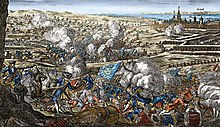
Copper engraving of the Battle of Helsingborg

Description of the campaigns after the turn of the war following the battle of Poltava in July 1709 until the conclusion of peace in 1721. In this phase, the warfare concentrated almost exclusively on the Swedish dominions. Thus, heavy fighting took place for the Swedish possessions in northern Germany, which ended in 1715 with the conquest by the Allies. Further battles took place in what is now Finland, the Baltic Sea and Norway.

Epiphany meeting: Frederick I of Prussia (centre), August II. (the Strong), Elector of Saxony and temporarily King of Poland (left), Frederick IV of Denmark (right). Painting by Samuel Theodor Gericke, on view in Caputh Castle
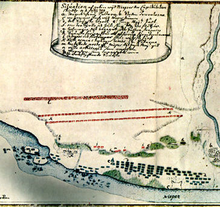
Depiction of the situation before the surrender at Perevolochna on 11 July 1709 (Russians = red; Swedes = blue).
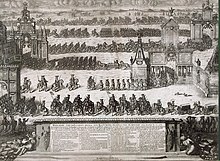
Triumphant entry of the Russian army into Moscow after the battle of Poltava
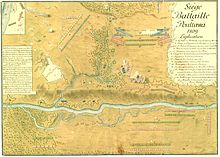
Map of the Battle of Poltava, with French commentary; Military Archives of Sweden, Stockholm
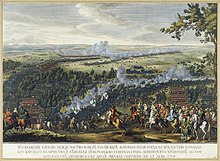
Depiction of the Battle of Lesnaya near the village of Lesnaya
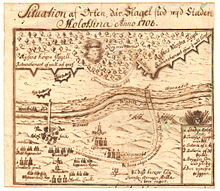
Swedish battle plan from the Battle of Golovchin on 14 July 1708

Depiction of the famous battle between the Russian and Swedish armies near Poltava on 27 June 1709.
Russian offensives in the East (1710-1714)
See also: List of Russian army units in the Great Northern War
After the turn of the war, the Allies had agreed on further attacks against Sweden. After Denmark had suffered a heavy defeat through the hasty invasion of southern Sweden, it concentrated, together with Russia and Saxony, on conquering the Swedish possessions in northern Germany. Russia simultaneously attacked the last possessions in the Swedish Baltic provinces. The Ottoman Empire's declaration of war initially delayed further offensive ventures against Sweden. Tsar Peter I suffered a defeat against the Ottomans, but was able to resume the war against Sweden in 1713 and conquer all of Finland by 1714. The Russian fleet-building programme resulted in winning naval supremacy in the Baltic Sea, leaving the Swedish coast defenceless against Russian attacks in the years that followed.
Complete conquest of Livonia and Estonia
While Charles XII was negotiating the Ottoman Empire's entry into the war with the Sultan, Tsar Peter completed the conquest of Livonia and Estonia. The Russians captured Vyborg by siege in June 1710, and on 4 July 1710 Riga capitulated after a prolonged siege by the troops of Field Marshal Boris Petrovich Sheremetyev. On 14 August 1710, Pernau surrendered after a short siege. After the surrender of Arensburg and the capture of the island of Ösel by the Russians, Reval (today's Estonian capital Tallinn) was the last fortress Sweden held in Livonia. After the Russian campaign through Livonia in the late summer of 1704, the fortifications had been extensively renewed and expanded, and the garrison was also increased to almost 4,000 men. The siege of the city by Russian troops began in mid-August 1710. The plague had broken out at the beginning of August, and its spread was accelerated by the influx of refugees and the resulting overpopulation. The situation deteriorated to such an extent that the Swedish leadership finally signed the surrender on 29 September, leaving the city in the hands of the Russian commander Fyodor Matveyevich Apraxin.
Under the command of Roman Bruce, a brother of Field Master General Jacob Bruce, a Russian contingent of troops was sent from Vyborg to the other side of the Karelian Isthmus to capture the fortress of Kexholm on the north-western shore of Lake Ladoga. After more than two months of siege, the Swedish fortress of Kexholm surrendered on 19 September 1710. This eliminated the danger of surprise attacks from the north for Petersburg. With the end of the campaign, the Russians gained three seaworthy Baltic ports and a vast, heavily secured environs of St. Petersburg, which was declared the new capital of the Russian Empire. Afterwards, Russia's attention shifted southwards for some time due to the war against the Ottoman Empire.
The war against the Ottomans
Tsar Peter's great victory at Poltava and his subsequent conquests in the Baltic were followed with suspicion, especially at the Sultan's court, where, in addition to Masepa and Charles XII, the Crimean Khan Devlet II. Giray urged countermeasures. Peter sent his ambassador Peter Tolstoy to Istanbul and demanded Charles' extradition, but this was refused. When Tsar Peter insistently demanded a decision by the High Porte on war or peace, Sultan Ahmed III had the ambassador thrown into prison in response. After Devlet II. Giray had invaded Ukraine in January 1711 with over 80,000 Tatars, supported by 10,000 pro-Swedish Ukrainian Cossacks, more than 4,000 Poles and 700 Swedes, Peter I declared war against the Ottoman Empire on 25 February in the Uspensky Cathedral in the Moscow Kremlin. On 8 March 1711, the Russian monarch received the Ottomans' declaration of war. This created a dangerous situation for Tsar Peter, which could jeopardise success at Poltava, as he was now in a two-front war and could hardly expect effective help from his allies.
For this reason, Peter I sought a decision on the offensive and invaded the Ottoman Empire with his army via the Dniester. He hoped for an uprising of Orthodox Christians in the Balkans that would prevent the Ottoman troops from crossing the Danube. However, this uprising, which had been promised to him by the Moldavian prince Dimitrie Cantemir, failed to materialise. On 5 July 1711, the Tsar, weakened by a serious illness, reached Jassy. On 17 July, the advance guard reported the advance of the Ottoman Grand Vizier Baltaji Mehmed Pasha. The entire Russian army now rushed back to the Pruth and was constantly engaged in retreating battles. When the 38,000 Russians entrenched themselves on 19 July at Huși, a small town on the Pruth, they were surrounded by several times superior Ottoman troops. Peter was now at the mercy or disgrace of the Grand Vizier, who, however, renounced the possible starvation of the Russians and instead accepted the Tsar's offer of peace, apparently tempered by payment of 250,000 roubles to obtain an honourable withdrawal. In the Peace of Pruth, Russia ceded the fortress of Azov, captured in 1696, back to the Ottoman Empire and undertook to withdraw from the Cossack territories. Charles XII continued to remain in the Ottoman Empire and tried unsuccessfully two more times in November 1711 and November 1712 to persuade the Sultan to go to war with Russia. The High Porte, however, had no financial means available for further warlike undertakings. The Peace of Adrianople of 24 June 1713, brokered by the maritime powers, settled the remaining differences between Russia and the Ottoman Empire.
Conquest of Finland
After the unsuccessful campaign on the Pruth, Tsar Peter turned back to the theatre of war on the Baltic Sea to increase the pressure on Stockholm. After overcoming some logistical problems, the long-planned invasion of Finland began in the spring of 1713. For the campaign in Finland, a combination of army and fleet was planned. To this end, the expansion of the Russian fleet was accelerated.13 large warships and frigates were available in 1713, and further ships were purchased in the Netherlands and England. However, special attention was paid to the construction of smaller ships. The galley fleet was given a fixed structure: three divisions of 50 ships each with 5400 marines were formed. Tsar Peter I had meanwhile departed from the siege of Toenning on 14 February 1713 and reached St. Petersburg on 22 March. The highly equipped Russian fleet, a total of 204 ships with 16,000 men, sailed from Petersburg at the end of April and landed near Helsingfors on 10 May. The Swedish commander there, Georg Lybecker, did not wait for the bombardment of the invasion force, however, but burned the city and, after he had also evacuated the Finnish capital Åbo (Turku) from the Russian pursuers, retreated with the Swedish garrison of about 3,300 men to the east, to Borgå, (Porvoo in Finnish), where a Swedish corps of 15,000 men stood. The Russian galley fleet then prepared an attack on Borgå. On the evening of 22 May, Russian marines landed unopposed near this town. In the meantime, a Swedish squadron under Vice-Admiral Lillie had appeared in front of Helsingfors. However, the Swedes avoided a battle. During their pursuit, three Russian ships of the line ran aground, but two could be refloated, the third had to be burnt. The Russians wrongly held Vice-Admiral Cornelius Cruys, who was of Dutch and Norwegian origin, responsible for this. The Russian sailors had not yet sufficiently mastered the difficult manoeuvring with large warships in the difficult fairway of the Gulf of Finland with its sandbanks, skerries and islands. The large warships were therefore sent back to St. Petersburg, while the more agile galley fleet remained in the Borgå area.
Before Tsar Peter, who attended the venture as a rear admiral, returned to Russia in September, he put Fyodor Matveyevich Apraxin in command of the fleet. With the Swedes, the unsuccessful Lybecker was replaced by General Carl Gustaf Armfeldt in August 1713. Lybecker had left behind a poorly equipped, starving and demoralised army, in which reconnaissance was particularly lacking, as the cavalry was no longer fit for such tasks. When the Russian general Mikhail Golitsyn marched into Ostrobothnia in February 1714, Armfeldt placed his forces in a defensive position near the village of Napo, east of Vaasa. After the Russian victory at the Battle of Storkyro on 19 February, the entire Swedish army in Finland was destroyed.
Russia wins naval supremacy in the Baltic Sea
For the threat to Stockholm, naval supremacy in the northern Baltic was a basic prerequisite. On land, the Russian forces were superior to the Swedish. On the water, however, the Swedes dominated with their large ships of the line, which could carry many guns. The Russian fleet's only chance of victory was a battle near the coast. Using all his resources, the Tsar doubled his Baltic fleet and placed the ships under the command of experienced Venetians and Greeks. At the end of May 1714, Admiral Apraxin set sail from Kronstadt with the mission of covering the further advance into Finland and landing on Åland. In August 1714, the two fleets faced each other at the Hanko Peninsula. After Peter I had personally brought in further reinforcements from the Baltic, the Russian galleys fought their way through the Swedish hail of guns during a persistent lull and boarded the immobile Swedish ships. The Russians then landed on the Åland Islands. The Russian fleet thus ruled the northern Baltic Sea.
The naval victory at Hanko had strategic significance. The Swedish ships deployed in the Gulf of Finland retreated. The Åland Islands were taken without a fight in August 1714. In addition, the victory also secured the conquest of southern Finland, which was completed with the taking away of the town of Nyslott (Savonlinna) on 9 August. The Gulf of Bothnia was now open to Russian ships. Even attacks against the Swedish heartland were now possible and measures were taken in Stockholm to defend against attacks at sea. In the autumn of 1714, Russian troops landed directly on Swedish territory for the first time at Umeå, and the town was abandoned by the garrison after a short battle. After destroying important military and economic installations, the Russians retreated back to Finland in October. Prince Golitsyn was appointed governor of Finland. The period of Russian occupation between 1713 and 1721 went down in Finnish history as the time of the Great Unrest.

The naval battle at Hangö on 27 August 1714
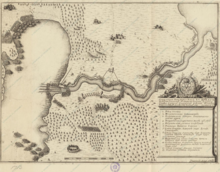
Battle of Pälkäne, 17 October 1713
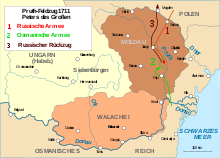
Pruth campaign of Tsar Peter I.
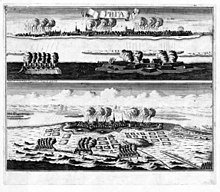
Siege of Riga 1710
Battle for the Swedish possessions in northern Germany (1711-1715)
While Russia had conquered the remaining Swedish fortresses in Livonia and Estonia in 1710 and 1711 and in the following years also brought the whole of Finland under its control, the conquest of the Swedish possessions in northern Germany proved much more difficult. The reason for this was the strong fortifications in Wismar, Stralsund and Stettin. In addition, the Swedes controlled the southern Baltic Sea and were able to land supplies and fresh troops several times to thwart the siege efforts of the Allies. The Danes, Russians and Saxons, for their part, had to put up with long approaches. Although this was the first and only time that the allies acted in a coordinated manner, disagreements and mutual distrust delayed more effective action, so that it took them three attempts to conquer the last Swedish bastions in Swedish Pomerania. Only the entry of Hanover and Prussia into the war in 1715 finally gave the coalition the military upper hand.
Futile siege of Wismar and Stralsund
After the failed invasion attempt in Scania in 1710, Denmark's war efforts shifted to northern Germany in the following year. Originally, the Danish King Frederick IV had planned another attack on Sweden from Zealand, but the plague on the island thwarted the execution. He therefore decided to concentrate his further war efforts on the Swedish possessions in northern Germany. The states of the Grand Alliance had a strong interest in keeping the war away from Germany. Thus, in the Hague Concert of 31 March 1710, Emperor Joseph I of Habsburg, in agreement with Holland and England, had stipulated the neutrality of the Swedish and Danish possessions in Germany. However, since Charles XII protested against this treaty, the Danes did not adhere to the agreement either in the following. A Danish army of 19,000 men gathered in Holstein and started the campaign in July. After a successful advance, the fortress of Wismar was blockaded by a Danish confinement corps under Lieutenant General Schönfeld from 17 August 1711. However, King Frederick IV's allies, especially Augustus the Strong, were able to convince the latter to concentrate all efforts on conquering the more important fortress of Stralsund. Thus the Danish army resumed its march through Mecklenburg, leaving only a weak observation and blockade corps in front of Wismar, which was unable to conquer the Swedish enclave. On 29 August 1711, Danish troops under the command of their king entered Swedish Pomerania for the first time at Damgarten. The Swedes had only 8,000 men there under Colonel Karl Gustav Düker. The Danes were joined in early September 1711 by Russian troops under Field Marshal Menshikov and Saxon troops under General Flemming from Poland. They had passed through the Brandenburg Neumark and the Uckermark and joined the Danish army before Stralsund. This was the first time that the members of the Northern Alliance proceeded in a joint operation. The Swedes, outnumbered, limited themselves to defending the two fortresses of Stettin and Stralsund as well as the island of Rügen due to the enemy's superior numbers.
The first siege of Stralsund by the allied armies took place from 7 September 1711, followed by others in the following years. The Swedish garrison consisted of 9,000 men under the command of Major General Ekeblad. However, the progress of the siege faltered because the allied siege army lacked heavy artillery and food for the approximately 30,000-strong force. This was due to coordination difficulties between the Allies. It was not until the beginning of November that a few ships with the requested artillery reached the siege army, which by then already had high losses due to disease and hunger. The Swedes still held naval supremacy in the southern part of the Baltic Sea and were thus able to effectively seize the besieged fortress from the opposite naval base in Karlskrona. On 4 December, the Swedish fleet, consisting of 24 ships of the line and four frigates, set sail from Karlskrona with this mission. On 8 December 1711, it put 6,000 Swedes ashore at Perth on Rügen in support of Stralsund. Frederick IV gave up hope of an early conquest and withdrew to Wismar and Mecklenburg with the remaining forces on 7 January 1712. During the seventeen-week siege of Stralsund, he had lost more than a third of his troop strength. In front of Wismar, the Danes managed to win the battle at Lübow against a large-scale attack by the Swedish garrison. But after the fortress had received a further 2,000 reinforcements from Sweden from the sea side, the Danes there also retreated to the winter camps in Mecklenburg.
Conquest of Bremen-Verden
Denmark concentrated on the Swedish imperial territory of Bremen-Verden in the campaign season of 1712, while Russia and Saxony attacked Swedish Pomerania. In 1712, the 12,000-strong Danish army marched into the Swedish duchy of Verden. This far-flung Swedish possession was very poorly protected. In the main town of Stade, the Swedish governor Count Mauritz Vellingk did indeed have 2,200 men as well as an unreliable land militia. However, the mood of the local population was increasingly hostile to Sweden due to years of recruitment, so that an uprising broke out which could only be put down by force of arms. Since the Elector of Hanover refused to allow the Danish army to pass through his country, the advancing Danes put their troops across the Elbe with 150 ships at Brockdorf and Drochtersen on 31 July 1712. Buxtehude and the Schwingerschanze posed no obstacles, and after Saxon artillery had arrived, the Danish army advanced before Stade. On 6 September 1712, the town was surrendered to the Danes. On 1 October 1712, the Bremerland also fell. Thus the whole of Bremen-Verden was conquered by Denmark.
Ottersberg and Verden were occupied by Electoral Hanover, which did not want to allow itself to be cut off from the sea again by the Danish increase in power. It was therefore in Hanover's interest to register its claims to the entire area for later peace negotiations. The Hanoverian ruling dynasty of the Guelphs tried to persuade Denmark to renounce the duchies by diplomatic means. In the protracted negotiations that followed, no breakthrough could be achieved at first, as Denmark pressed for high financial compensation. It was not until George I became King of England at the end of 1714 and had a great power with a strong fleet behind him that movement came into the negotiations. Although Great Britain did not participate directly in the war, it provided indirect help to the Nordic allies through its naval presence in the Baltic Sea. When Prussia assured Hanover of possession of Bremen-Verden in an alliance treaty on 27 April 1715, Denmark could no longer resist the diplomatic pressure in the anti-Swedish coalition and ceded Bremen-Verden on 2 May 1715 in return for a Hanoverian compensation payment.
Swedish campaign to Holstein
→ Main article: Stenbock campaign
In the campaign year 1712, Russia's war efforts were initially directed at Stettin, whose conquest was hoped to persuade Prussia, which was interested in the Oder estuary, to enter the war against Sweden. To this end, the Russians assembled 40,000 men in front of the city in June 1712. Denmark wanted to support the attack by transferring its siege artillery; its own could not be carried by the Russian army because of the long march. However, due to the delays in transporting the Danish mortars and cannons, Field Marshal Menshikov lifted the blockade and moved on against Stralsund, for whose second siege 7,000 Saxons and 38,000 Russians were mustered. In the meantime, new recruitments had been made in Sweden to carry the war onto German or Polish soil and thus relieve the hard-pressed fortresses in Swedish Pomerania. On 3 September, the Swedish fleet sailed from Karlskrona with 24 ships of the line, three frigates and 130 transport ships with 10,000 men. A few days later, Magnus Stenbock, who had been promoted to field marshal, landed on Rügen with the Swedish army. However, the majority of the transport ships were destroyed by the Danish war fleet on 28 September 1712 (→ Sea battle off Rügen), as the Swedish warships were outmanoeuvred by the Danes and they left the unarmed transport fleet defenceless. This loss disrupted supplies to the landed Swedish troops, and the planned second transport with a further 6,000 men, artillery and the supply train could not take place either. After the Swedish soldiers had recovered somewhat on Rügen, they were taken to Stralsund.
Due to the landing of the Swedish troops, the siege of Stralsund by the Allies had to be broken off again. However, the city was not in a position to support such a large army in the long term. Because a return transport was also impossible, Stenbock had to make a break for it in order to push the coalition units back from Pomerania and shift the war to Mecklenburg and Holstein. However, as the Saxon and Russian troops had drawn trenches from Greifswald to Tribsees during the blockade of Stralsund, a breakthrough by the Swedes in Pomerania was not possible and so Stenbock had to make his way through Mecklenburg. On 2 November, he set off with 14,000 infantry and cavalry. The breakout led over the pass near Damgarten across the Recknitz to the Pomeranian border. On 4 November, the entire Swedish army was on Mecklenburg soil. The Danish and Saxon troops standing there then retreated. On 5 November, the Saxon Elector, who had advanced to Tribsees and Sülze, had the situation explained to the Danish King Frederick IV and asked for a unification of the troops. However, this had become impossible due to the advance of the Swedes. The Swedish army moved on to Rostock and captured the city, as better communication with Wismar, Stralsund and Sweden was possible from there. The Saxon and Russian troops had followed Stenbock's movements and moved towards Güstrow. During negotiations between the warring parties, a fortnight's truce was agreed, which was to be used by the Allies to encircle the Swedish army and buy time, as the Danes were still lagging behind in their advance.
Stenbock saw the need to attack the opponents individually before they could unite. More reinforcements arrived from the garrison in Wismar for the planned enterprise. When Stenbock heard of the approach of the Danish army under Frederick IV, he decided to attack the Danish army first, even before it could unite with the Saxons and Russians. He therefore gave orders to march to Neukloster. After the campaign in Bremen-Verden and as a result of further losses through disease and desertions, the Danish army consisted of only 17 battalions of infantry below target strength, 46 squadrons of cavalry and 17 pieces of light artillery, a total of about 15,000 men, 6,000 of them mounted. The Danes were expecting Saxon reinforcements, but these did not arrive until after the battle had begun, in a strength of about 3,000 men.
In the following battle of Gadebusch, the Swedish army was victorious on 20 December 1712 against the allied Danes and Saxons, who lost 6,000 men and began a hasty retreat. However, the Swedish army had also suffered heavy losses in the battle and continued to experience supply shortages. The Danish infantry had been scattered, but was soon able to reorganise and remained operational despite the heavy losses. Field Marshal Stenbock therefore decided to march with his battered army to Holstein, as a better supply situation could be expected there and Denmark could thus be put under further pressure. During the advance, in January 1713, he had the town of Altona burnt down in retaliation for the previous Danish attack on Stade. He then moved on to the Danish duchies of Schleswig and Holstein. However, a union of the Danes with the Saxons and Russians made the situation untenable for the Swedish army in Holstein. The Russian army had in the meantime caught up with the Swedes, and the Russian Tsar Peter I personally led this enterprise. On 31 January 1713, Russian troops pushed the Swedish army into the fortress of Tönning, which belonged to Schleswig-Holstein-Gottorf. There, in February 1713, Magnus Stenbock and 11,000 men were surrounded by a superior number of Danish, Russian and Saxon troops and forced to surrender on 16 May 1713 after a three-month siege. The Swedish general spent the rest of his days in Danish fortress custody, where he employed himself as a miniature carver, whose inimitable filigree work is a craftsman's enigma.
Conquest of Szczecin
Bremen-Verden, Stettin and the unprotected land in Swedish Pomerania were under Allied control at the beginning of 1713. At the same time, Russian forces took the offensive against Finland. With the loss of the field army under Stenbock, the remaining forces could not bring about any change in the situation in Swedish Pomerania. The forces of the Swedish Empire were already too strained for that. Gottorf seemed equally lost to Sweden. Prussia, which had so far kept out of the conflict, was also only waiting for a favourable moment to enter the war. In order to save the German possessions for Sweden, diplomatic agreements were to be made to place the fate of Stettin in the hands of a third, neutral power. However, Sweden's cession negotiations with Prussia failed. Instead, the new Prussian King Frederick William I led the negotiations on a cession of Szczecin with the Allies. The latter marched unhindered from Holstein back into Pomerania after the end of the siege of Tönning. In retaliation for the destruction of Altona, Wolgast and Gartz were reduced to rubble. In August 1713, Russian and Saxon units led by Prince Menshikov launched an attack on Stettin, which had a garrison of 4,300 men. The city surrendered on 19 September 1713 after an eight-hour bombardment by Saxon siege artillery had destroyed large parts. A few days after the surrender, the Allies reached an agreement with Prussia in the Treaty of Schwedt, which was to take over the city as a neutral occupying power and was allowed to keep it in the future against payment of 400,000 riksdaler. After paying this sum, Prussian troops marched into Stettin on 6 October 1713. In June 1713, a Saxon army began the third siege of Stralsund. At the same time, a Saxon-Danish army landed on Rügen, but was unable to gain lasting ground there. Due to supply shortages and coordination difficulties among the Allies, the siege of Stralsund was also abandoned again in October.
The entry of Prussia and Hanover into the war
In the meantime, Swedish Pomerania, with the exception of Stralsund and the enclave of Wismar, had been completely conquered by the allied Danes, Russians and Saxons or occupied by Prussia as a neutral power. Prussia had ended its policy of equalisation between the adversaries, which had been pursued for over ten years, after Frederick I had signed the Peace of Utrecht to end the War of the Spanish Succession. The Berlin leadership therefore seized the opportunity to intervene in the final phase of the Northern War with the freed-up troops in order to achieve the old goal of ousting Sweden from the southern Baltic coast.
After the death of the first Prussian king in February 1713, the new policy was continued by his successor Frederick William I. He concluded a treaty with Denmark on 22 June 1713 which provided for a joint occupation of Western Pomerania and offered Prussia the part south of the Peene River. On 6 October 1713, Russia and Prussia also agreed that Prussia should receive the area up to the Peene (with Usedom and Wollin) for administration. On 12 June 1714 they concluded a treaty that definitively assured Prussia of the acquisition of part of Western Pomerania. An alliance between Prussia and Hanover of 27 April 1714 also served the same purpose. The circle of Charles XII's enemies closed when Elector Hanover, which had been granted possession of Bremen-Verden by Denmark, joined the Russian-Prussian agreement in November 1714. The Elector of Hanover had also been King of Great Britain and Ireland since 1714. After the surrender of Bremen-Verden to Hanover, Prussia, using the Swedish seizure of Usedom as an opportunity, declared war on Sweden on 1 May 1715. This was followed on 15 October by Hanover's declaration of war on Sweden. The Kingdom of Great Britain remained excluded from the war, which only affected George I's ancestral lands.
The two maritime powers, England and the Netherlands, were in great anxiety about their maritime trade in the Baltic due to the war. After Charles XII had ordered his merchants to stop trading with all enemies, England sent a British fleet to the Baltic in May 1715 under the command of Admiral John Norris to protect the English and Dutch merchant ships. The British fleet united with Dutch warships there, thereby forcing the Swedish navy at Karlskrona into inactivity. The Anglo-Dutch fleet also actively intervened in the war effort itself, with eight English and Dutch ships joining the Danish navy in the siege of Stralsund in July 1715.
The Return of the King
There was no fighting either in front of Stralsund or Wismar in 1714. The Saxons had withdrawn from Pomerania and Peter I was busy conquering Finland. Denmark itself had no financial means for a new campaign. Even in this extremely critical situation for Sweden, Charles XII rejected several peace offers. However, after there was no prospect of the Ottoman Empire entering the war against Russia again, and the latter had been forced to leave its camp at Bender (in present-day Moldavia) since February 1713 in the melee of Bender, Charles returned to Swedish Pomerania in November 1714 in a fifteen-day forced march. His return was prompted not only by the Sultan's request but also by the political upheavals in Sweden, which threatened to pose a serious threat to his rule. Acclaimed by the people of Stralsund, his aim was to restore the former balance of power in Pomerania, misjudging the situation. Under his leadership, the expansion of the fortifications was accelerated, involving up to 10,000 people. In addition, he reestablished a small army which, although poorly equipped, was loyal to him.
Capture of the last Swedish fortresses
→ Main article: Pomeranian campaign 1715/1716
In January 1715, Charles XII occupied the southern and eastern coasts of Rügen to secure the Stralsund fortress. On 23 February he took Wolgast, which was occupied by a twenty-man Prussian post. On 22 April, Swedish troops landed on the island of Usedom and took a small Prussian detachment by surprise.
Thereupon Frederick William I had the Swedish envoy expelled and gave orders for the planned Pomeranian campaign to begin. Prussia declared war on Sweden on 1 May 1715. On the same day, the Prussian army moved into a camp near Stettin, which was joined a fortnight later by a Saxon corps of 8,000 men under General August Christoph von Wackerbarth. The supreme command of the Prussian contingent was assumed by King Frederick William I himself. Under him, Field Marshal Prince Leopold I of Anhalt-Dessau was in command. In the second half of June, the Danish army began its advance through Mecklenburg. A Danish detachment of four battalions and twelve squadrons under the command of Lieutenant General Friedrich von Legardt captured Wismar, the Swedes' second base on German soil with a garrison of 2,500 men. King Friedrich Wilhelm I reinforced the siege troops with two battalions and twelve squadrons under the command of Major General George Friedrich von der Albe. The siege corps now numbered about 8,000 men. At sea, Danish ships blocked the entrance to Wismar.
On 28 June, the Prussian-Saxon army set out from its camp near Stettin. Meeting no resistance, the Prussians crossed the Peene by means of a pontoon bridge at Loitz and the Saxons at Jarmen and joined up with the Danes in front of Stralsund in mid-July. The Danes, under the command of Field Marshal General Carl Rudolf von Württemberg, had crossed the Recknitz near Damgarten and had also met no enemy resistance.
Charles XII had previously withdrawn his remaining troops in Pomerania to Stralsund, as he did not want to risk a decision in a field battle due to the numerical and qualitative superiority of the allied forces. On 12 July 1715, the three allied armies united in front of Stralsund and began the siege. A Swedish squadron operating at Ruden off the mouth of the Peene River was defeated in the naval battle at Jasmund on 8 August 1715 by the Danish fleet, which had arrived in full in the meantime. As a result of the naval battle, the Swedes' strength at sea was broken and their fleet had to retreat permanently to Karlskrona. The Allies succeeded in conquering Rügen on 17 November, making the besieged city's situation almost hopeless. After a month-long siege of Stralsund, the enclosed Swedes surrendered on 23 December 1715. King Karl was able to escape in a fishing boat across the Baltic Sea to Sweden at the last moment under fortunate circumstances. The siege of Wismar, which was joined by two battalions and four squadrons of the Electorate of Hanover on 2 November, dragged on throughout the winter and caused great discomfort to the besieging troops because of the severe cold. After a ten-month siege, Wismar was finally taken by Prussian and Hanoverian troops on 19 April 1716. With this, the last Swedish possession in northern Germany also fell.

Schematic representation of the siege of Stralsund 1715
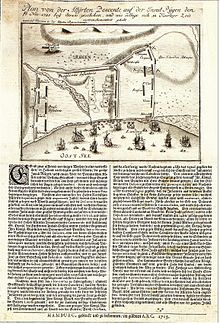
Schematic representation of the Allied landing and deployment at Stresow and the point of attack of the subsequent Swedish attack

The Swedish camp at Bender, 1711. After the Sultan had granted asylum to Charles XII and his companions, a fortified camp was built south of the town of Bender. In the upper section of the picture, the king is depicted riding and accompanied by Axel Sparre.

Swedish Cavalry in the Battle of Gadebusch

Appeal by Magnus Stenbock to the inhabitants of Schwartau while he had established his headquarters there from 20 to 31 December 1712.
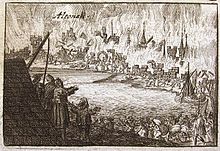
Danish Altona is burnt down during Stenbock's campaign in 1713.
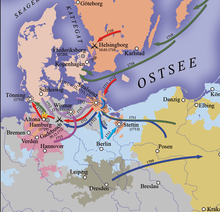
North German theatre of war between 1711 and 1715
The final phase of the war (1716-1721)
After his return to Sweden, Charles XII undertook several military campaigns to Norway. In the meantime, the Russian navy dominated the Baltic Sea and carried out disruptive actions against the Swedish coast. Overall, however, the final phase of the war was characterised more by diplomatic upheavals among the alliance partners than by military action. The shift in the balance of power triggered by the Russian victories over Sweden, which was very consciously perceived at the European courts, triggered fears among the established European great powers about a possible Russian domination of the Baltic region. England proved to be the greatest opponent of Russian power dominance in Northern Europe. As Tsar Peter at times maintained large troop contingents in Denmark, Mecklenburg and Poland, the Holy Roman Empire, the Netherlands, France, Saxony and Denmark joined the English line.
Charles XII tried to take advantage of the tensions between his war opponents and negotiated peace agreements with both sides. However, historians doubt the seriousness of these attempts. Charles believed until the end that he could bring the war to a favourable end for Sweden by military means. It was not until after his death in 1719 that Sweden turned completely to England, made peace with Denmark, Prussia and Hanover and hoped, with England's support, to regain the Baltic provinces it had lost to Russia. However, due to the danger of a new war with Spain, the powers were not prepared to dare an open war with Russia, so Sweden was left alone and had to make peace with Russia on unfavourable terms.
Europeanisation of the Baltic Sea question
Further efforts by Tsar Peter I to gain a foothold in northern Germany strengthened the distrust of the other allies, resulting in delays and disagreements in further action against Sweden, which prolonged the war. George I, King of England and Elector of Hanover, supported Russia in order to gain a land bridge to England with Bremen-Verden, but was also afraid of Russia dominating the Baltic too strongly and was therefore prepared to change course. English fears became acute when Tsar Peter I concluded an alliance treaty with Duke Karl Leopold of Mecklenburg on 19 April 1716, to whom he also offered the hand of the Tsar's niece Catherine Ivanovna. Russia thus received a base for its army on German soil and gained Mecklenburg as a further ally against Sweden. In return, the duke received help against his estates in the conflict with the knighthood. In the winter of 1716/17, 40,000 Russian soldiers took up quarters in the Duchy of Mecklenburg-Schwerin. From then on, the Tsar played an important part in imperial politics, also because of his kinship relations with Mecklenburg. The English Parliament, like Emperor Charles VI, now wanted to prevent further Russian penetration of the Baltic region, fearing that Russia would monopolise Baltic trade. After complaints from the Mecklenburg estates about their duke's continued breaches of the law, Emperor Charles VI imposed an imperial execution order on Charles Leopold of Mecklenburg in 1717.
Formation of an anti-Russian alliance
After Charles XII returned to Sweden from Stralsund, he took advantage of the allied disagreements in his efforts to restore his empire by concentrating his forces against Denmark-Norway. During the winter of 1715/16, Charles planned to march across the frozen Baltic Sea from Scania to Zealand. However, the winter turned out to be mild, so that this plan was not feasible. So he decided to move against the Danish province of Norway. He was able to capture Christiania (today's Oslo) in Danish-controlled Norway, which had been abandoned by its inhabitants, and then moved against Fredrikshald, but after the Danes burned his fleet, he had to return to Sweden in July, which meant that the Norwegian campaign of 1716 failed.
The invasion of Norway encouraged Copenhagen to invade Sweden again. The plan of a joint Russian-Danish invasion had already been discussed for some time. In February 1716, Peter I presented a detailed invasion plan in Altona during his second trip to Europe. Russian troops were to be transported as far as Sjaelland. From there, together with Danish troops, Sweden was to be invaded, supported by a British fleet.
However, the diplomatic upheavals caused largely by Russian activities in Mecklenburg disrupted the invasion plan and fuelled the allies' distrust of the Tsar. It was suspected at the European courts that Peter had concluded a separate peace with Sweden and merely wanted to use the invasion plans as a mask for an expansion of Russian bases in Germany. At a meeting of Peter I and Frederick IV on 28 May 1716 in Hamm and Horn near Hamburg, the invasion plans were further elaborated. In September 1716, a 30,000-strong army was shipped on Prussian ships from Warnemünde in Mecklenburg to Zealand. A Danish army of 24,000 men was already there. The Danish navy, consisting of 24 ships of the line, was reinforced by the Russian navy and galley fleet as well as British and Dutch naval squadrons. The Allied invasion fleet, consisting of 67 ships of the line and frigates, was now ready to invade Schonen. But then the Tsar, who had just returned from a trip to Europe, unexpectedly cancelled the already firmly planned landing, thereby arousing the suspicion of the allies once again, who continued to suspect that Peter I merely wanted to establish himself in the empire. After the tsar's attempt to forge a Franco-Russian alliance during a stay in Paris was unsuccessful, a diplomatic offensive by England finally led Russia into foreign policy isolation. Around January 1717, George I concluded a Triple Alliance between Britain-Hanover, the Netherlands and France. Hanover and Denmark withdrew from the Nordic coalition. In March 1717, the English Parliament gave its consent to the use of the fleet to enforce the new English foreign policy. The Triple Alliance was supplemented in August 1718 by Austria, which had just made peace with the Ottoman Empire. The now formed Quadruple Alliance was expanded by the Treaty of Vienna in January 1719, by which Saxony, England-Hanover and Austria joined forces to push Russia back from Poland-Lithuania, which maintained a 35,000-strong army there.
Start of Russian-Swedish peace negotiations
→ Main article: Åland Congress
While diplomatic upheavals took place in 1717, the year brought a lull militarily for all warring parties. Despite all the defeats and the overwhelming superiority of his enemies, King Karl constantly developed new ideas and plans. Georg Heinrich von Görtz, Karl's closest advisor in his last years, sensed an opportunity to reach a separate peace with the Russians in order to have a free hand for reconquests in northern Germany and Denmark in return.
At a meeting with Tsar Peter at the Het Loo pleasure palace in Holland in August 1717, Görtz was able to dispel the Tsar's major reservations about a rapprochement, and peace negotiations took place on the Aland Islands from May 1718 onwards in the following year. The negotiators for the Swedes were Görtz and Carl Gyllenborg, for the Russians the Westphalian Heinrich Ostermann and the Scottish general James Bruce. The Swedish plan provided for Russia to retain all its possessions except Finland, but for Norway and Hanover to fall to the Swedes. Furthermore, a landing in Scotland was to prepare for a return of the Jacobites to the throne there.
The Death of the King
The allied disagreements gave rise to new hope in Stockholm for a favourable peace agreement. The start of the new Norwegian campaign was to demonstrate Sweden's seemingly unbroken strength to both the Tsar and the English. While Charles himself marched with the main army against Frederikshald, General Armfeld had to move north across the Kiölen against Trondheim with another division in order to cut off the connection between the two parts of the country. In Sweden, however, the campaign met with general disapproval. The country was at the end of its tether, and in Stockholm even starving people were found in the streets. Many officers and soldiers were also suffering from hunger, and the greater part of the Swedish army had torn clothes. When King Charles XII fell victim to an enemy bullet in the front line at the siege of Frederikshald on 30 Novemberjul/11 December 1718greg, the Nordic War was as good as over at a stroke. Immediately after the king's death, his brother-in-law Prince Frederick lifted the siege and led the army back to Sweden.
The campaign to Trondheim also ended in disaster. When Armfeldt ordered the retreat to Sweden on 12 January 1719 on the news of the king's death, a snowstorm set in on Öyfjell so fiercely that 3,700 of the 5,800 soldiers froze to death. The demise of Armfeldt's army went down in history as the Death March of the Carolinians.
With the death of Charles XII, the Swedish line of the House of Wittelsbach ended in the male line. After him, his sister, Ulrika Eleonore, ascended the throne. Her coronation had been made conditional on her acceptance of a new constitution that dissolved the absolutist monarchy and transferred legislative power to the Imperial Diet consisting of representatives of the four estates (nobility, clergy, burghers and peasants). Executive power was vested in a secret committee of the first three estates. In this way, the anti-Russian aristocracy once again had the government of the country in its hands, a position of power it retained for more than 50 years. After his wife's renunciation, Frederick of Hesse-Kassel, Ulrika Eleanora's husband and Charles XII's brother-in-law, obtained the Swedish crown, but subsequently remained dependent on the Imperial Council. At a stroke, the foreign policy course changed. On the advice of French and English envoys, negotiations with Russia were broken off; instead, peace negotiations with Great Britain-Hanover, Prussia and Denmark were pushed forward under French mediation. A strong European alliance against Russia was now emerging, the outlines of which became clear when, in February 1719, the Emperor charged the Electorate of Hanover with carrying out the imperial execution imposed two years earlier and 12,000 Guelph soldiers drove Duke Karl Leopold out of Mecklenburg.
Peace with Hanover-England, Prussia and Denmark
Sweden was the first to make peace with Hanover-England after protracted negotiations. As late as 1718, the Swedish king had only agreed to cede a small part of Bremen-Verden, but not the entire duchies of Bremen and Verden. Only his death at the end of 1718 cleared the way for promising peace negotiations, which began in Stockholm in May 1719. Points of contention were the amount of the redemption sum for Bremen-Verden, the extent of Sweden's future losses in Pomerania and the use of the English fleet to protect Sweden against a Russian or Danish attack.
At the same time, Sweden was under strong military pressure from Russia. Thus, on 24 May 1719, the Russian fleet won its first victory in the open sea battle at Ösel. In order to force Sweden to sign the peace treaty, Peter I decided on a landing operation in the Swedish heartland. At the same time, a landing operation took place south and north of Stockholm in August 1719. The operation involved 20 ships of the line, several hundred rowing ships and 26,000 landing troops. In the course of the invasion, eight major cities were destroyed, including Norrköping, the second largest city at the time. Through Grand Admiral Apraxin, Tsar Peter had the coast of Western Bothnia burnt down. 13 towns, 361 villages and 441 noble estates were destroyed.
The Russian advances accelerated Sweden's peace agreements with its other adversaries. In November 1719, Denmark ceased hostilities with Sweden. Under the mediation of the English plenipotentiary John Carteret, the war with Great Britain was ended on 22 November 1719 in a preliminal peace at Stockholm. Hanover received the duchies of Bremen-Verden in return for a payment of one million riksdaler and indirectly promised Sweden English support. The cession was not finally recognised until the Hamburg settlement of 1729.
After protracted negotiations between Prussia and Sweden, the Peace of Stockholm was concluded on 21 January/Jul. / 1 February 1720greg. Prussia retained Stettin, the islands of Usedom and Wollin as well as Vorpommern up to the Peene for a financial consideration of 2 million riksdaler. On July 3 / July 14, 1720greg, Denmark and Sweden ended the war in the Peace of Frederiksborg after more than eight months of negotiations. Denmark returned Rügen and Western Pomerania north of the Peene as well as the dominion of Wismar to Sweden, which paid 600,000 thalers in return and renounced the freedom of customs in the Sound. Of the occupied Gottorf, Denmark returned only the Holstein parts to Duke Karl Friedrich, while all of Schleswig was now united under the Danish crown.
By this time, England had built a large coalition against Russia, but it was not enough to end the warfare in the north. Prussia and Saxony tended to back away from Britain in order to turn once again to the Tsar. The Emperor in Vienna also became restless due to the continued occupation of Mecklenburg by Guelph troops.
Peace with Russia
England's decision to deploy its fleet sailing in the Baltic Sea under the command of Admiral Norris against Russia fell short of expectations. The English squadrons were unable to follow the Russian ships into the Gulf of Finland. The English fleet also failed to stop the Russian attacks on the Swedish mainland. On 7 August 1720 a Swedish squadron was defeated by a Russian one in the naval battle of Grönham, and in 1721 Stockholm itself was saved from a Russian attack only by the arrival of a British fleet. Britain now realised that it was unable to form an effective war coalition against Russia. Prussia maintained a strict course of neutrality, and the other English initiatives at the courts in Vienna and Warsaw were also unsuccessful. As a result, the United Kingdom now also pressed for peace negotiations with Russia to begin as soon as possible. As a result of a speculative crisis, it was no longer possible for the British King George I to support the Swedes financially. Thus, the Swedes, who were left without support, had no choice but to enter into direct peace negotiations with Russia under French mediation, which began on 28 April 1721 in Nystad, a small Finnish town not far from Åbo.
On 10 September 1721, Sweden ceded the territories of Ingermanland, Livonia, Estonia, the islands of Ösel and Dagö, and South Karelia to Russia in the Nystad Peace Treaty. In return, it received back Finland, which Peter I had conquered in 1714. Russia also paid Sweden reparations amounting to 2 million riksdaler. Sweden received the right to buy grain worth 50,000 roubles duty-free every year in Riga, Reval and Arensburg, except in years of poor harvests.
In the course of the peace negotiations at the end of the war, Queen Ulrika Eleonora also offered August the Strong an armistice on 7 January 1720. In this offer she deliberately chose the title "Frederick August", expressing the fact that the Saxon elector was still not recognised as Polish king by Sweden after his re-election in 1710. Although August II hoped to link recognition of his Polish kingship with a revision of the Peace of Altranstadt, no conclusion was reached. Saxony-Poland, although an active party to the war, was thus not involved in the peace agreements that ended the Great Northern War. A mutual affirmation of the de facto state of peace between Saxony and Sweden did not take place until April 1729. The Polish Sejm had previously decided at Grodno in 1726 to enter into peace talks with Sweden and to confirm earlier peace agreements, primarily the Treaty of Oliva. After an initial declaration of intent in 1729, negotiations began again, in the course of which Sweden in February 1730 and Poland in September 1732 presented drafts that resulted in a mutual declaration of peace.

The signing of the peace treaty of Nystadt on 20 August 1721. etching, 1721

Naval Battle of Grönham on 7 August 1720
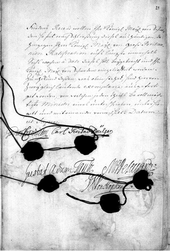
Image of the last page of the Preliminary Peace at Stockholm between Hanover-Great Britain and Sweden of 19 November 1719.

Siege of Frederikshald 1718 Copper engraving from the Theatrum Europaeum
,_målning_av_Gustaf_Cederström_(1845-1933).jpg)
The body of Charles XII is transferredG . Cederström Krusenberg, 1884

Georg Heinrich von Görtz (right) gained great influence on Swedish foreign policy in the last years of Charles XII's reign (1715-1718). He advocated a settlement with Russia.
Consequences and effects of the war
The war had a serious impact on population development in the Swedish Empire. At the end, there were only three men for every five women, which meant that mainly women had to take over agricultural work. Finland suffered the highest losses and lost 16 percent of its population. In Sweden, the blood toll was ten per cent. Finland was so badly affected that the Swedish governor refrained from levying taxes for six years.
The Great Northern War resulted in a fundamental shift in the European balance of power. Sweden lost its possessions in the Baltic and in Germany (except for Wismar and Western Pomerania north of the Peene), which also revised the Peace of Westphalia with the ousting of Germany from the seas at the mouths of the Weser and Elbe. As a result, Sweden lost its position as a major Nordic power, even if some in Sweden did not yet want to admit this - so in 1741 a war against Russia was unleashed, which ended in further disaster. In Sweden, the so-called freedom period followed until 1772 - an epochal designation that refers to the overcoming of absolute royal rule. From then on, the estates had the say.
From then on, Sweden was replaced as the major Nordic power by the Russian Empire, which not only rose to become the new superpower on the Baltic Sea, but also played a decisive role in the reorganisation of Europe. However, the Nordic War had demanded the utmost of the Russian people. At times, 82 percent of the state's revenues were spent on the war. Between 1705 and 1713 alone, there were ten musterings that called some 337,000 men to arms. Service conditions were so poor that 54,000 Russian soldiers died of disease during the Great Northern War, compared to about 45,000 mortally wounded. Peter's new capital, Saint Petersburg, was built on the Baltic Sea, protected by wide coastal areas - a development that the maritime power Britain, concerned about its Baltic trade, was unwilling to see. In the midst of the war, Peter the Great thus created the foundations of Russia's great power position; to underline the new claim, he had the Russian Tsardom renamed the "Russian Empire" and officially changed his title from "Tsar" to "Emperor" (Император, Imperator). Russia was once again a firm member of the European system of states and alliances after centuries of alienation caused by Mongol rule.
The war also decided the fate of Estonia and Livonia. Livonia, which henceforth belonged to Russia, was able to maintain its internal autonomy for some time. In the Peace of Nystadt in 1721, Emperor Peter granted the Estates privileges binding under international law, which were confirmed by all subsequent emperors up to Alexander II (1855). (1855). The privileges include: Freedom of faith, German administration, German language, German law. Estonia, Livonia and Courland (from 1795) are therefore also called the "German" Baltic provinces of Russia.
Russia's rise was accompanied by the decline of Poland-Lithuania, which slipped into political anarchy (symbolised by the Liberum Veto) and fell into the sphere of influence of the Tsarist Empire, de jure degraded to a Russian protectorate from 1768 and was completely divided up by its neighbours (Prussia, Austria and Russia) by 1795. The Northern War left the territory of Belarus, which belonged to Lithuania, completely devastated. The Russian army did not leave the country until 1719, and agriculture, crafts and trade were devastated. As a result of the plague, thousands of inhabitants died, so that the population of Belarus was reduced by almost a third. While in 1700 it was still 2.2 million people, in 1721 it was only 1.5 million.
The decline of Sweden and Saxe-Poland-Lithuania in turn freed Brandenburg-Prussia from two strong potential opponents in the region and coincided with the latter's rise in power politics, even if, following English intervention, Sweden was able to retain the northern part of Swedish Pomerania and, in tow of England, was henceforth to form a counterweight against Brandenburg. After they had moved up the ranks of the European states in the course of the Great Northern War, Russia and Prussia completed the pentarchy of the great European powers alongside France, Austria and Great Britain in the following centuries.
Denmark emerged from the war slightly stronger. On this basis, a settlement was now in the offing between Denmark and Sweden, who had fought so many wars against each other in the previous century.
In addition to the sometimes drastic effects of war on individual states, the entire Baltic region was hit by a plague epidemic of enormous proportions during the Great Northern War in the period from 1708 to 1712 (cf. Great Plague in Prussia). Starting with the epidemic in Poland, the plague reached a deadly dynamic within a few years, spreading as far north as Stockholm. A major catalyst for the plague was the Great Northern War, which caused a significant number of people to pass through large parts of northern and eastern Europe within a short period of time, thus contributing quite decisively to the spread of the plague.

Territorial changes in Northern, Eastern and Central Europe due to the peace treaties of Nystad (1721), Stockholm (1719/1720) and Fredericksborg (1720): Russian gains (Baltic provinces, Ingermanland, Karelia). Hanoverian gains (Duchy of Bremen-Verden) Danish gains (ducal share of Schleswig) Prussian gains (parts of Western Pomerania)
Warfare and strategic aspects
Warfare in Europe was characterised by a fundamental similarity in the weapon systems and tactics of the opposing armies and fleets. By the turn of the century, new weapons and techniques had been developed, such as the spout bayonet and the flintlock rifle in the late 17th century. This led to an increase in firepower and greater tactical flexibility, as all infantry were now equipped with muskets. More effective drill also now became possible, with drill and discipline being crucial to firepower. More linear infantry formations were now used on the battlefield.
There were far fewer fortifications in Eastern Europe than in Western Europe at this time. For example, France had a system of forward fortifications through Vauban's constructions, which made war of movement and extensive operations difficult. In contrast, those involved in the Great Northern War found it easier to conduct large-scale advances, as was the case with Charles XII's invasion of Poland in 1701, Saxony in 1706 and Ukraine in 1708. But there were also individual fortresses in north-eastern Europe that could be of importance for the control of individual regions. For this reason, the conquests of Vyborg, Reval, Mitau and Riga in 1710 by Russia, or of Stettin in 1713, Stralsund in 1715 and Wismar in 1716 by Denmark and Prussia were important stages in the collapse of the Swedish Empire.
The Swedish military machine was subjected to extensive reform under Charles XI after the disappointing results from the Nordic War of 1674 to 1679. In particular, Sweden's long borders were difficult for the Swedish army to defend. For this reason, Charles XI still pursued a defensive strategy in which he had new fortresses built, developed rapid mobilisation procedures (Einteilungswerk) and maintained a large army even in peacetime. Sweden had 50 fortresses and 40 redoubts on its outer borders. Since the Baltic Sea was largely a Swedish body of water, fortresses on the borders of the empire were to hold off enemy attacks until the Swedish fleet (assuming naval supremacy) transported a relief army across the sea from the motherland. This strategy was used very successfully, especially at the beginning against Zealand, off Narwa and off Riga.
It was precisely this naval supremacy in the Baltic Sea that was bitterly fought over. By 1720, Russia had become the strongest sea power in the Baltic. In addition to battles between warships with a large draught, there were also battles between fleets of galleys. These were particularly practical in shallow and insular waters such as those often found in the Baltic Sea, e.g. the Gulf of Finland. Battles on lakes, in lagoons and on rivers also had their significance. For example, Swedish and Russian flotillas fought each other on Lake Ladoga and Lake Peipus at the beginning of the war.
In the battle tactics on land, the fighting style of Gustav II Adolf (Sweden) was adhered to. Due to the long borders and limited resources, the Swedes relied on fast, daring offensive advances with close coordination of the infantry, cavalry and artillery arms. Infantry and cavalry often attacked the enemy lines at the same time, so that they often completely collapsed due to the force and brought about a quick battle decision. These engagements, however, required a very high level of discipline and highly experienced officers and men. Charles XII's bold, always attack-oriented fieldcraft was more like that of the Persian prince Nadir Shah than the cautious style of many, if not all, Western European commanders. The victory at Klissow in 1702 over a larger Saxon army was typical of Charles XII's reckless fieldcraft, always willing to take risks. In particular, the brilliant victory at Narva in 1700 over the still-forming Russian professional army confirmed Charles XII's awareness that the art of war had to be the epitome of the political. However, he did not sufficiently consider that security policy was still constitutional policy, i.e. fundamentally based on legal claims. Consequently, the diplomats in Stockholm and in his field chancellery were reduced to extras. Charles' military thinking thus led to isolation in the long run. The heavy defeat at Poltava in 1709 was therefore only the military expression of a political non-perception of the realities in a Europe that was simultaneously experiencing the War of the Spanish Succession in the southwest.
The Russian approach to warfare relied on the availability of the greater resources. Especially in the battles up to 1709, Russian victories were based primarily on numerical superiority, as the military reforms implemented after 1700 only achieved their full effect in the long term. For example, at the beginning of the war, the Russian metallurgy, which was only beginning to develop, could not meet the army's need for muskets until 1712, so that in 1707 the proportion of pikemen was actually increased compared to musketeers. Peter's efforts to rebuild a Western-style army were mainly concerned with military organisation and administration. He created a general staff and introduced the infantry attack with bayonets fixed as a shock tactic in response to the impetuous attack of the Swedes. He also had highly mobile field artillery developed. He introduced the dragoon type - infantrymen on horseback, following the Swedish example. He had disciplined pursuit tactics devised and intensified efforts to establish an organically regenerating officer corps. However, while the infantry gained a high degree of effectiveness, the cavalry remained prone to weakness, partly due to incorrect tactical deployments and poor quality horses. All in all, the Russian army grew into a fighting organisation that was in no way inferior to the Swedish or other armies. In 1700, after the battle of Narva, the Russian military strength was 34,000 men; in 1705, the total strength was 200,000 men.
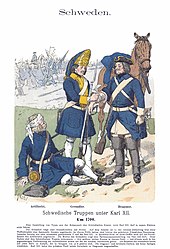
From left to right: Illustration of a Swedish artilleryman, grenadier and dragoon around 1700. Colour lithograph by Richard Knötel, end of the 19th century

Saxon Musketeer of the Regiment on Foot Count Flemming. 1711, Colour lithograph by Richard Knötel, end of the 19th century.
The Political Legacy of the Nordic War in the 21st Century
After the end of France's supremacy in Europe in 1713, a balance of power was to follow in Europe. Since the antagonisms in the North threatened to disrupt this, "peace in the North" was necessary for the continued preservation of peace in Europe. This was initially accompanied by the ideal of a balance of the Nordic powers, which, however, shifted in the 19th century to an absolute dominance of Russia, while maintaining the calm. But this imbalance led to new sources of conflict in the emerging age of nation states. Just as in East-Central and South-Eastern Europe, the basic conflict of states tearing nations apart and therefore nations trying to tear states apart also worked in North-Eastern Europe. This is evidenced by the formation of states by Norwegians, Finns, Estonians, Latvians, Lithuanians and Poles in the second decade of the 20th century. As a consequence of National Socialist expansionist policies and the security needs of the new Soviet Union, the world of small states of the interwar period from Danzig to Tallinn disappeared again - first through the division of spheres of interest between Hitler and Stalin in 1939 and the German war of aggression and extermination in the East, then through the post-war demarcation of the new blocs of NATO and the Warsaw Pact.
The end of the bipolar world in the watershed year of 1989 led to the dissolution of the USSR, the reunification of Germany and the restoration of the North-Eastern European nation states of Estonia, Latvia, Lithuania, Belarus and Ukraine. The upheaval of 1989 brought about a return of the European region of Northeast Europe to political reality, such as the establishment of the Council of Baltic Sea States in 1992. The epochal year 1989 brought about a sense of déja vu in St. Petersburg and Stockholm in particular, which continues to this day, and brought the historical commonalities of the two Nordic metropolises back into consciousness. Finally, the public and governments of Finland, Sweden and Denmark "rediscovered" their responsibility for the security of the Baltic states.
Russia's access to the Baltic Sea shrank significantly due to the dissolution of the Soviet Union. What remained was the area around St. Petersburg (the former Ingermanland, which belonged to Sweden at the beginning of the Great Northern War) and northern East Prussia, which remains Moscow's outpost as the Kaliningrad region. This gave a change to the northeast European centricity of Petrine Russia, expressed in the translatio imperii away from Moscow to the city of Peters. Nevertheless, the contours of north-eastern Europe can be clearly discerned in modern Russia, since the "Novgorodian" north-west, with Leningrad renamed back to St. Petersburg, is an important electoral base for the reform forces.
An additional integrating element in the 21st century is trade. The region is bisected by two main trade routes, the Northern Route and the Baltic Route. Both routes periodically had not only regional as well as European, but also global economic significance, since in the early modern period they functioned as transit routes between China, Central Asia and the Near East on the one hand and the trading states of England and the Netherlands on the other. The Moscow Tsardom, Poland-Lithuania, Sweden-Finland and especially Denmark-Norway with its strategic positions at Øresund and North Cape profited from the region's function as a world trade hub, as did other states and cities - Brandenburg-Prussia, Holstein-Gottorp, Lübeck and Courland. This specific transport-geographically determined position of Northeast Europe in early modern trade was therefore - in addition to its function as a producer and exporter of goods in high demand in the West, such as grain, forest products, shipbuilding materials, non-ferrous metals and others - a constituent element. The implosion of the Soviet Union in 1991 has brought about a new edition of this transit function insofar as a large part of the increasing exchange of goods between the EU and the CIS is now routed via North-Eastern Europe (e.g. the Baltic Sea pipeline).

Council of the Baltic Sea States Summit in Vilnius 1-2 June 2010
Search within the encyclopedia